
Vietnam, Cambodia and Thailand
January 24 - February 8, 2024
Mike and Judy Henderson
I served in the Army in Vietnam from June 2, 1970 to August 2, 1971 - it's been 52+ years since I left Vietnam. For a lot of years, I never thought much about my service in Vietnam, but now, I'd like to go back and see what the country looks like. I'm sure it has changed a lot.
Vietnam had a major impact on me. I was young, drafted immediately after I graduated from college, and it was the first time I had been out of the United States. After basic training, AIT (Advanced Infantry Training), Infantry OCS (Office Candidate School), and then more training, I was sent to Ft. Riley, KS. That location was so bad I volunteered for Vietnam (there was no other way out of Ft. Riley).
Of course, going to Vietnam was dangerous, but if I had stayed at Ft. Riley I would have died of boredom. Luckily, when I got to Vietnam, I was assigned a job that was fairly safe - I was not out in the jungle carrying a rifle. After being there for a while, I found that I liked the country and the Vietnamese people. I met my first wife (a civilian office worker from the states) there. You can see more of my story here - I hope you'll take a look.
This tour also gives us a chance to see Angkor Wat.
The tour starts in Hanoi and we're going to take a day trip to Ha Long Bay which I've always wanted to see (of course, it was impossible for me to see Ha Long Bay during my tour there - it was in North Vietnam!)

++++++++++++++++++++++++++
1/20/2024 (Saturday) Judy's cousin, Jean, is traveling with us and arrived this evening from Bend, OR. There was a snowstorm in her area and the Redmond airport was closed down yesterday. She was on the first flight out of the Redmond airport today, and arrived safely.
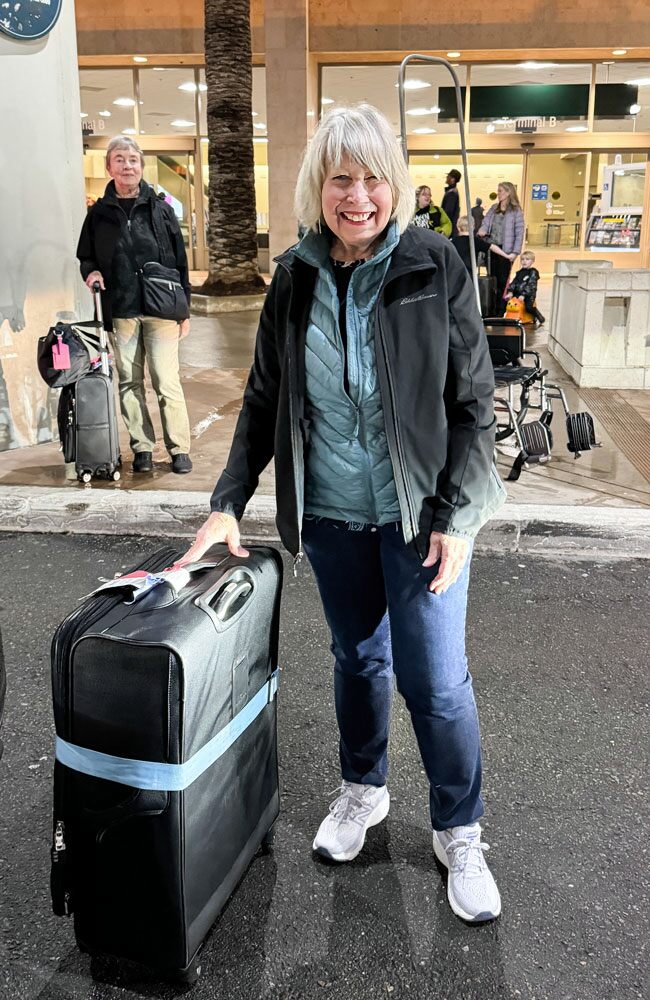
She arrived a bit after 7pm.
++++++++++++++++++++++++++
1/21/2024 (Sunday) Our flight doesn't leave until 11pm so we finished packing and went to lunch at Lazy Dog. Later in the afternoon, our friend Greg came by. He's going to say in the house with the girls.
Here's our departure photo - the whole family. Greg has Annie and I have Lizzie.
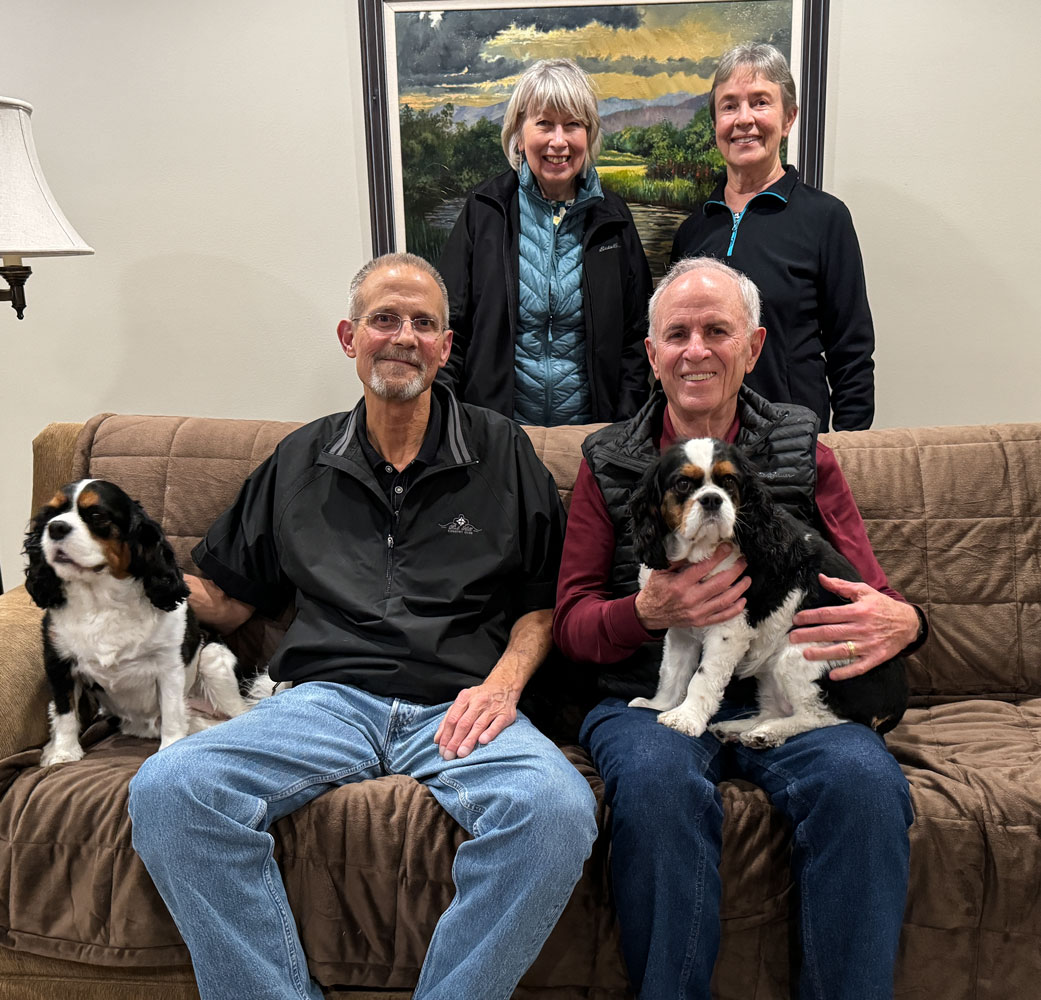
The limo came a bit early, and Lynn and Greg gave us a "military salute" as we left. Lynn comes from an Air Force family. Her father was a colonel and fighter pilot, and her two brothers were colonels in the Air Force. Greg was a SeaBee (CB - Construction Battalion) in the Navy.
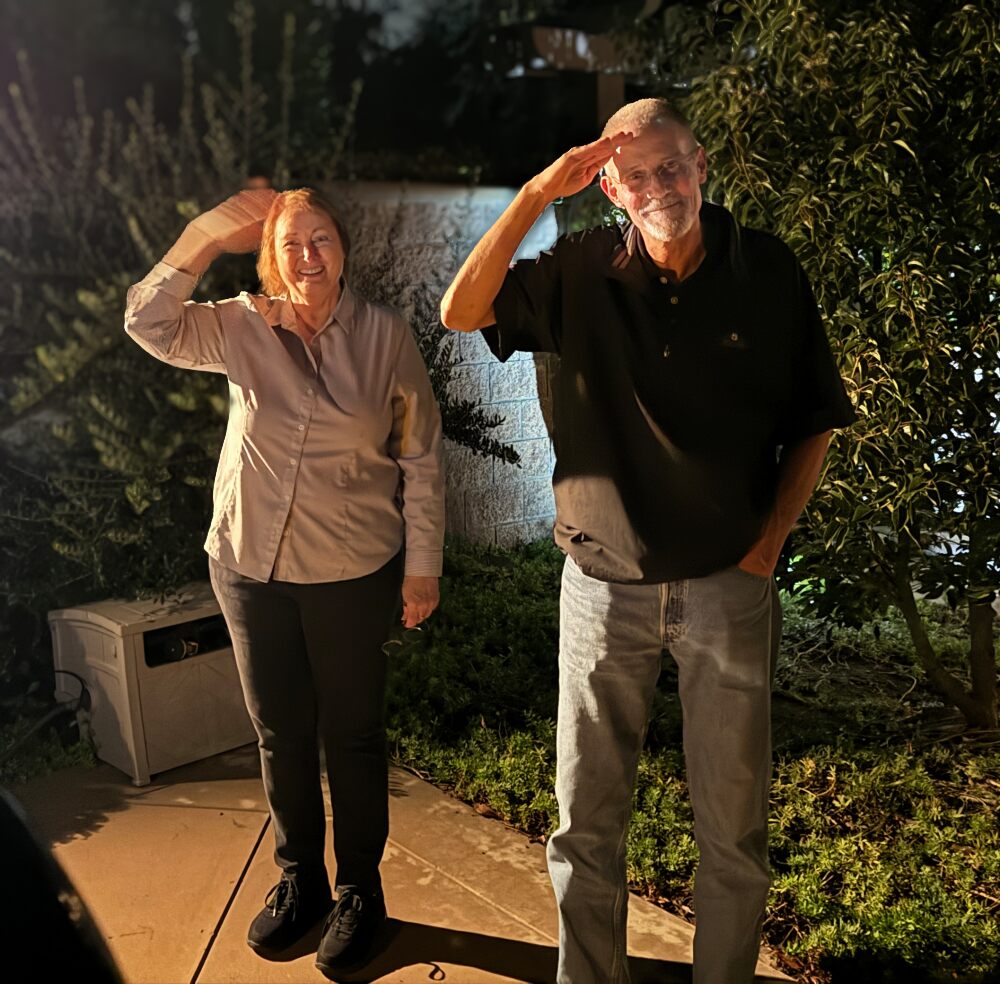
Traffic was very light (Sunday) and we were at the airport by 7:30pm. Check in and security were no problem and we waited in the lounge.
The plane was an Airbus A-350-900, and was very nice. Like the Boeing 787, the A-350 is made mostly from carbon fiber, so the cabin altitude is lower and it seems quieter.
The aircraft pushed back from the gate at 11:15pm, but we didn't take off until 11:45pm. Lots of aircraft traffic at LAX.
The business class seats were very satisfactory. Since it was so late, Judy and I skipped dinner and immediately went to bed. I slept until 6am (LA time). We still had six hours to go, however, so I watched a movie (Bohemian Rhapsody, not a bad movie if you like the music of Queen).
++++++++++++++++++++++++++++++++
1/22-23/2024 (Monday/Tuesday) We crossed the International Date Line sometime during the flight and advanced one day. We managed to get some sleep on the plane and they woke us for a nice breakfast. The service and food on Asiana Airlines was very good. It's just amazing that you can fly across the Pacific Ocean, non-stop, in about 12 hours, and sleep through most of it:-)
We arrived in Seoul a bit early, just after 5am local time (the airport is actually in Incheon). It was chilly - about 7°C (44°F), in the jetway. We depart from the same terminal but had to go through a security check, and the security people were thorough - the security guy really went through everything in Judy's shoulder bag (twice). There was a long line for security but it moved fairly quickly.
After that, we went to the Asiana lounge (a large, nice lounge) to wait for our flight to Hanoi, which is scheduled to depart at 9:10am. We went to the gate in good time, and boarded. The aircraft is a Boeing 777-200, and it pushed back about 9:15. It was about a four and a half hour flight to Hanoi (Hà Nôi in Vietnamese).
[Side note: The Vietnamese language used to be written using a script similar to Chu Hán, Chinese written script, known as Nôm script or Chu Nôm. In 1624, Alexandre de Rhodes, a Jesuit missionary was sent to Asia and he eventually developed a method of writing Vietnamese using Latin letters, an extension of work initiated by the Portuguese Jesuit missionary Francisco de Pina. His technique was published in 1851 and eventually became the official technique for writing Vietnamese. [End side note]
We got to Hanoi about 11:45am and must have arrived when all the other flights arrived. The passport control room was packed. The area where you present your passport is way at the end of this room - and there were people behind us.
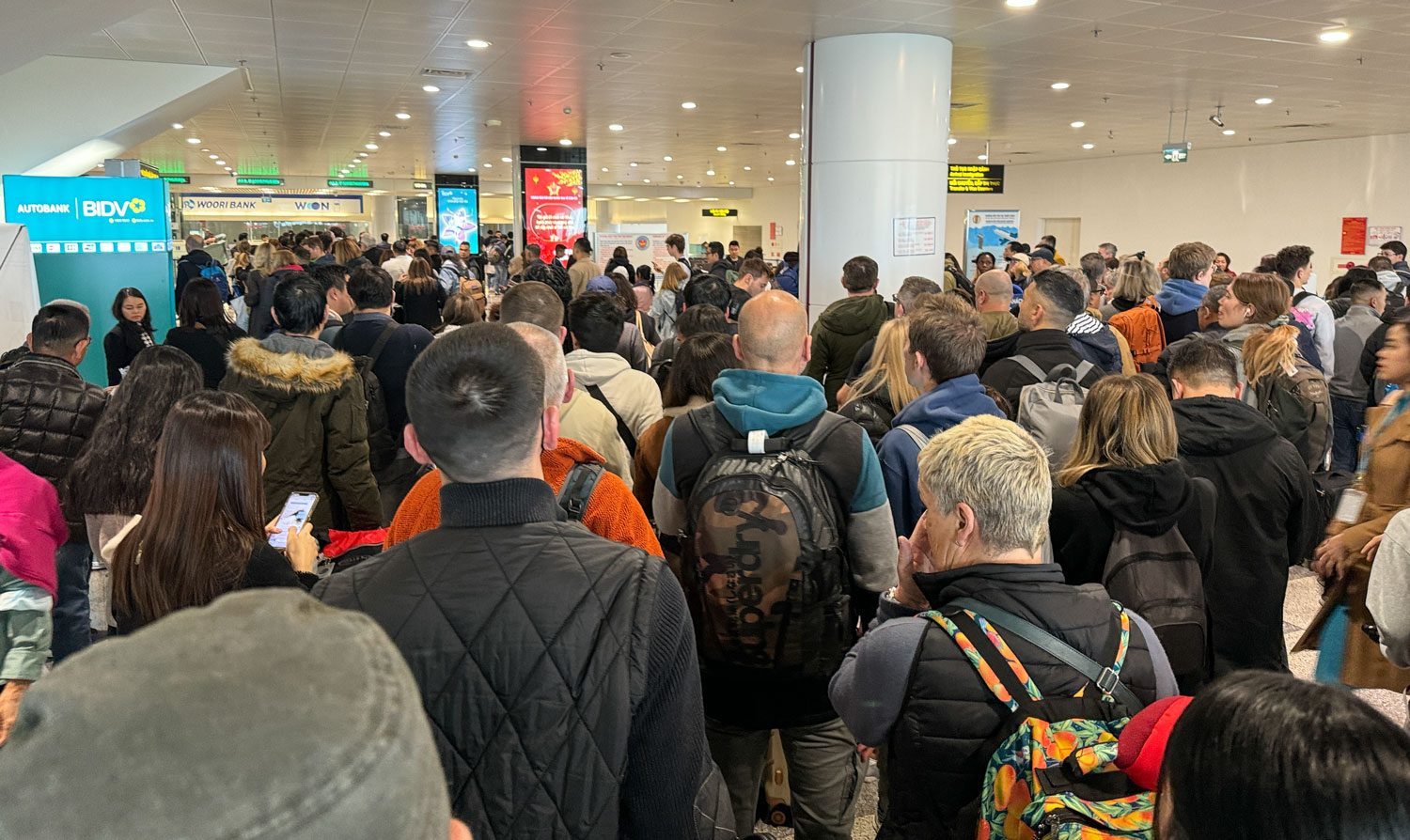
But eventually, we got through passport control and collected our bags. The Tauck greeter was waiting for us at the entrance to the terminal. The airport is large and modern, just like any airport in a larger US city.
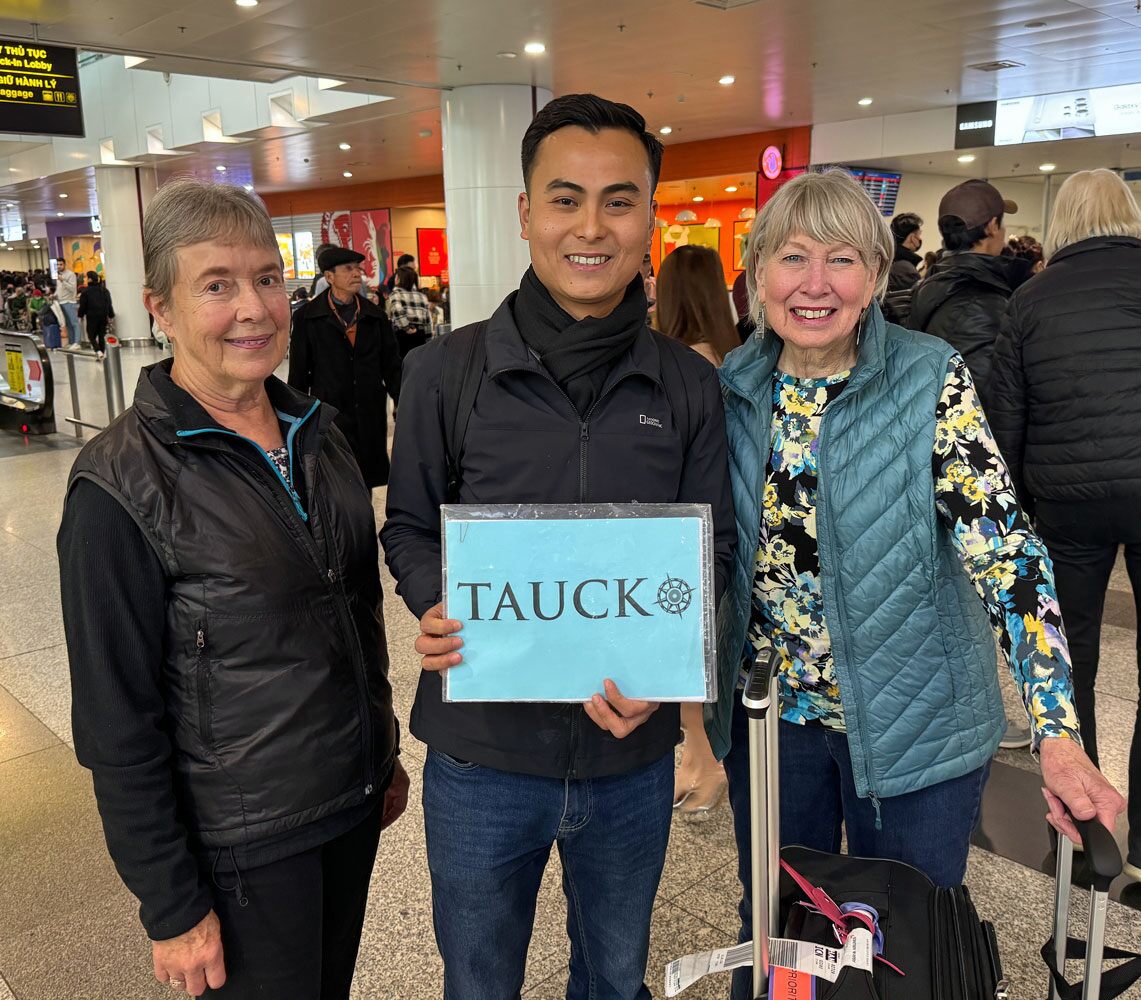
His driver came by, and we headed to the Hotel Metropole. On the way to Hanoi, we traveled over the Ðông Trù bridge, a fairly new bridge (2014) over the Ðuông River which uses an innovative construction technique, steel tubes filled with concrete. Picture from the web.

This picture of the Metropole is from the hotel website. It's on a busy road, so they must have stopped traffic to get this picture.

It's an old hotel, first opened in 1901, but freshly renovated. The staff is excellent.
We're in the renovated older wing of the hotel, on the first floor above the reception area (called floor 1 here and in Europe) - our room is very well appointed. Not huge, because hotel rooms in the past were not that big - but certainly big enough and very nice. The room has two double French doors that open to a small balcony.
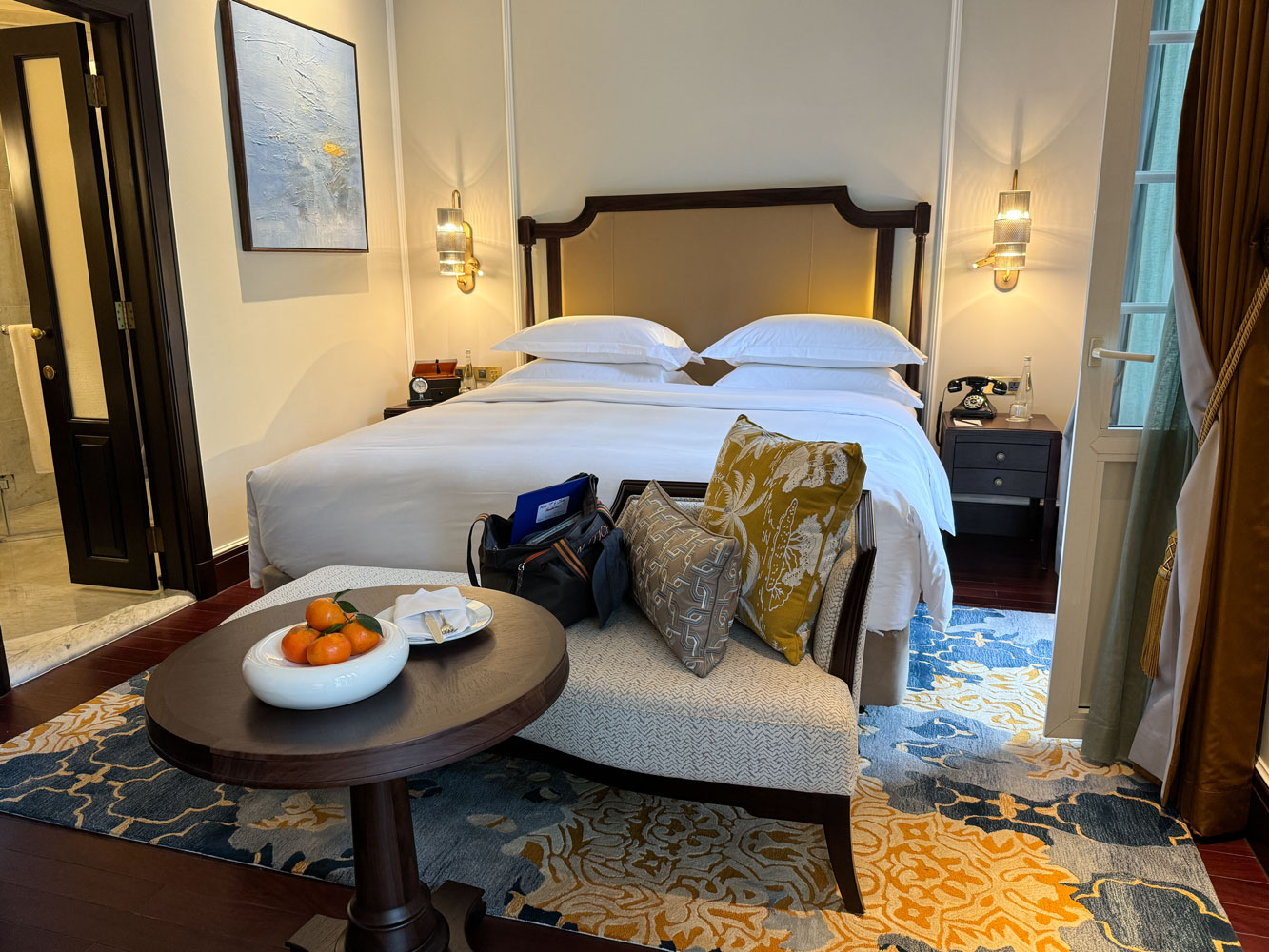
The bathroom has a walk-in shower, which is something I much prefer to a tub shower. It also has one of those new Toto toilets with the heated seat. Nice on a cold night. The only thing missing was an electric blanket:-)
I thought the Metropole was an excellent hotel.
We wanted something light to eat, so we went to the afternoon tea. They really offer a nice spread.


That was our day. We went up to our room and decided to go to bed early.
+++++++++++++++++++++++++++++++++
1/24/2024 (Wednesday) As usual on the first morning of a tour we were up early, about 4am. We have a day tour to Ha Long Bay today. This is separate from Tauck - I arranged it privately through the hotel. I first became aware of Ha Long Bay because of the French film Indochine, staring Catherine Deneuve, and wanted to see the bay for myself. It would have been nicer to do an overnight on the bay, but we just couldn't get flights which would allow us to get in a day earlier.
We took our time getting ready this morning - the restaurant didn't open until 6am. Breakfast in the buffet restaurant was quite good, and extensive.
Then, at 7:30 we received a phone call that the tour guide was here. I called Jean and we met the guide in the lobby. His company had told him to arrive at 7am, but no one told us. I had even checked with the concierge last night and was told the tour guide would meet us at 8am.
With a bit of scramble, we departed the hotel at 7:45. It was fairly cold this morning, about 7°C, and everyone was bundled up. Here's our guide, Hung Nguyen, and the driver, Tung, just before we departed. The van was a brand new Ford, with seating for eight.

Note the two tricycle vehicles in the upper right of the picture. We called those "pedalos" back when I was in Saigon. But these are much nicer than the ones back then.
Incidentally, there's an art to entering and leaving a pedalo. If you step on the foot support area to get in, the back of the pedalo will come up. It might work if the driver is sitting in his seat, but the safe way to get in is to step over the foot support so that both feet are on the ground, with your back to the driver, then sit down and finally, pull your feet in.
To get out, reverse what you did. Put one foot down on either side of the foot support, then get up and swing one leg over the foot support. You're out.

Here's the route to Ha Long Bay. We go through the outskirts of Haiphong.
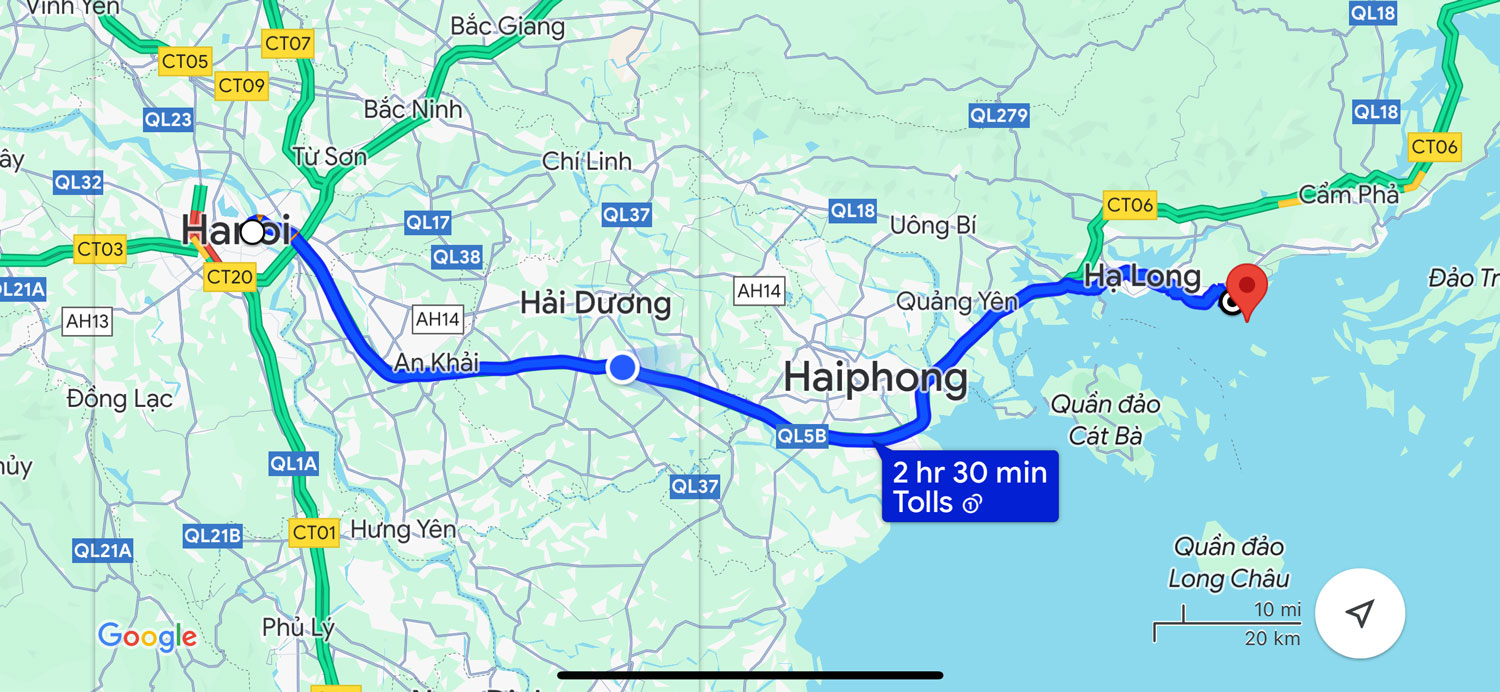
Getting out of Hanoi was a bit of a problem because of the traffic, but most if it was coming into Hanoi so it wasn't too bad.
Going across the Chuong Duong Bridge across the Red River was interesting. The bridge was completed in 1985. It was designed with a two-lane, two-way, vehicle roadway inside the structure, with a pedestrian and two-wheeled vehicle lane on either side of the main structure. It's just packed with vehicles. This picture (taken from the web) does not do justice to the traffic we encountered. And the bridge looks a lot better in this picture than it did in "real life". The picture is probably one of those architectural renderings, with fake traffic.
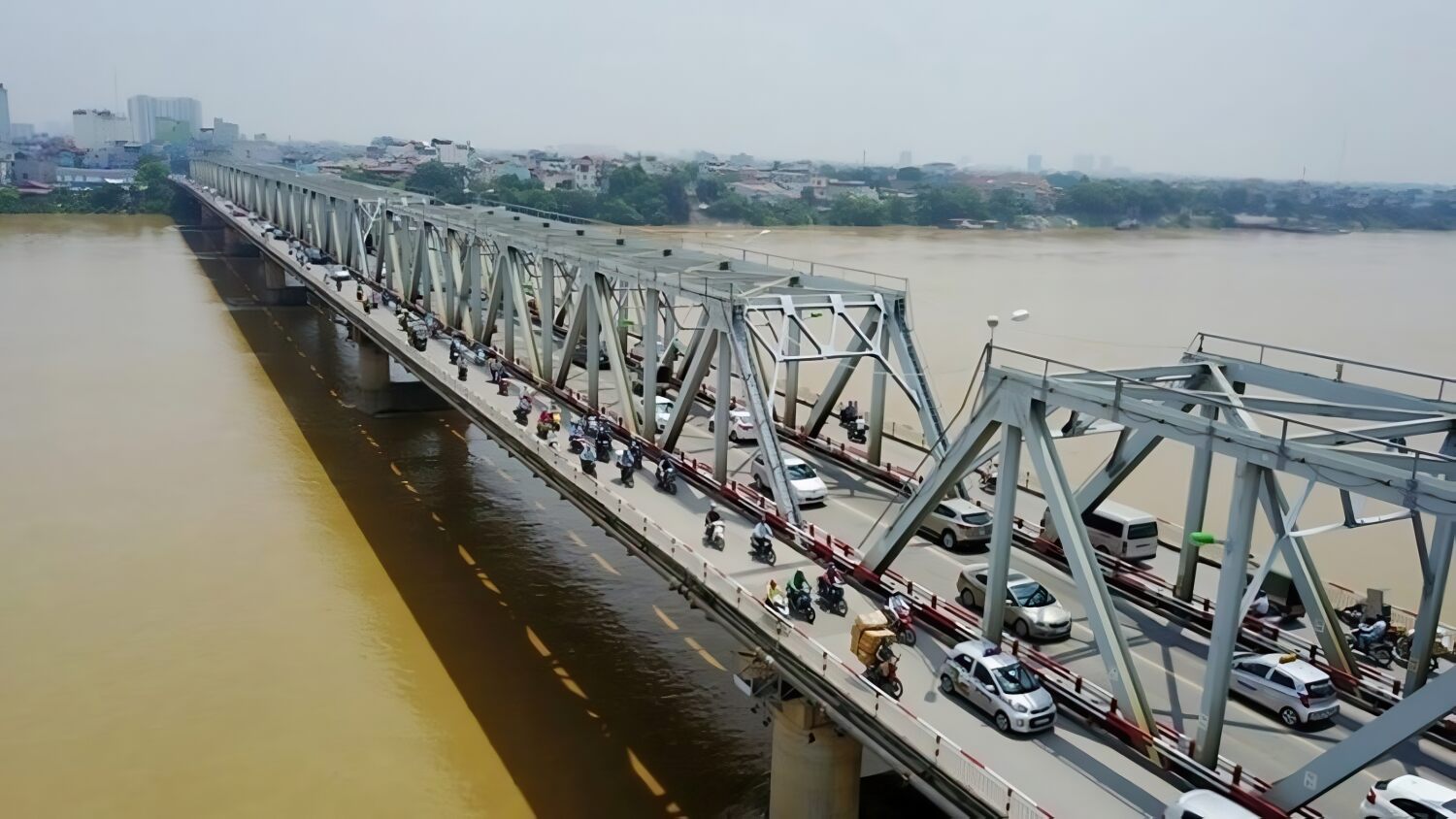
From the Chuong Duong Bridge we could see the Long Biên bridge. That bridge was completed in 1902, and looks it (picture from the web). It was designed with two railway tracks inside the structure, and a vehicle lane on either side of the main structure. At this time, only pedestrians and two-wheeled vehicles can use the bridge.
The tour guide will tell you that Gustave Eiffel designed the bridge, but that's not true. It was designed by a French company, Daydé & Pillé Company. Eiffel had no involvement with that company.
At the time of the American involvement in the war, it was the only bridge across the Red River in Hanoi, and was attacked many times. Sections were destroyed several times, but the Vietnamese rebuilt it each time. Analysis after the attacks showed that the destruction of the bridge did not seriously hamper the North Vietnamese.
Defense of the bridge became a point of honor to the North Vietnamese and it was very heavily guarded with anti-aircraft weapons. On one of our earlier trips, I met a guest, William (Bill) Shankel, an A-4 pilot who was shot down in 1965 over Hanoi while attacking that bridge, and spent seven years in the Hanoi Hilton.

The highway between Hanoi and Ha Long Bay was quite good - a typical expressway, with tolls. The countryside was mostly agricultural, a lot of rice paddies.

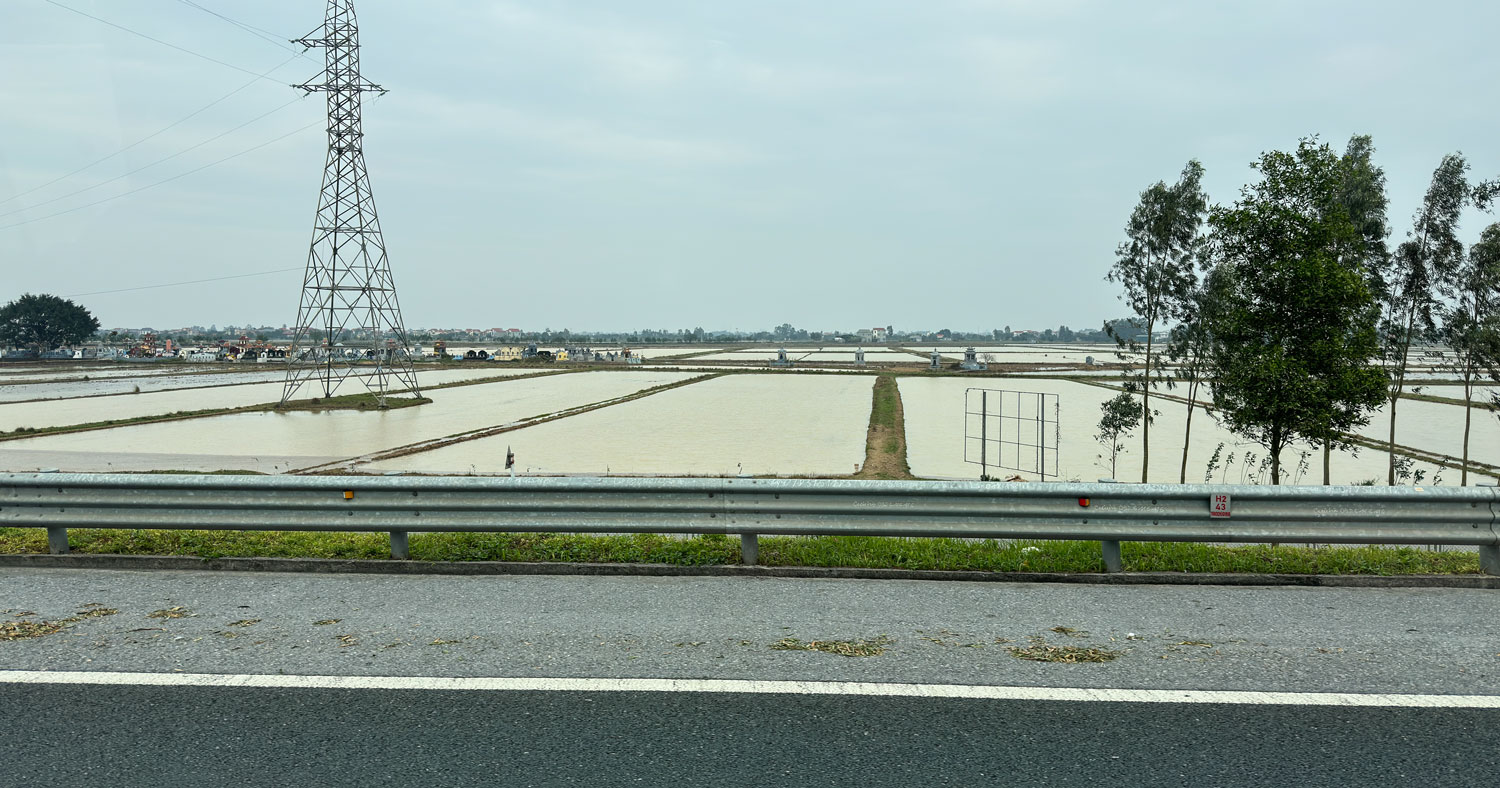
We passed Haiphong on the coastal side of the city, which put us on the Binh Bridge over the Cam River. It's a double cable-stayed bridge and has a clearance of at least 25 meters over the river. It was opened in 2005 and reduced the time to get from Hanoi to Ha Long Bay by quite a bit. There used to be a ferry to cross the river.
From the top of the bridge, we got a great view of the Haiphong harbor.

During the Vietnam war, North Vietnam was supplied by both Russia and China. Supplies were brought in by ship, primarily to Haiphong. The US had to be very careful when attacking the harbor because of the risk of hitting a Russian or Chinese ship, thereby possibly provoking war between the US and Russia or China.
Here's the harbor area.
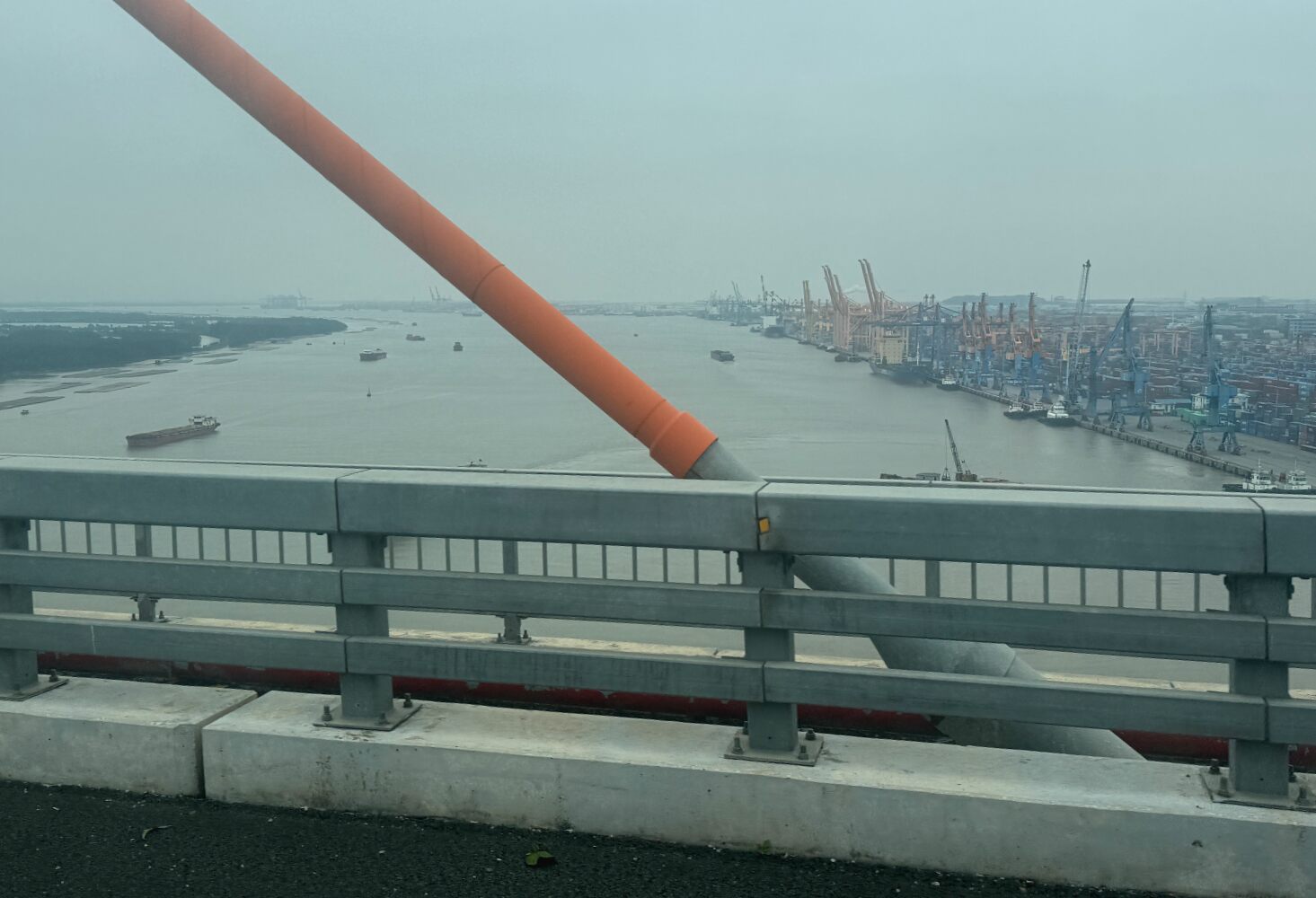
We arrived at Ha Long Bay at 10:15, two and a half hours after leaving the hotel. We're heading to Tuân Châu island where we'll catch the boat. There's a long causeway to the island. That rectangle at the end of the road is the harbor.


The tour boats are lined up along the side of the harbor.
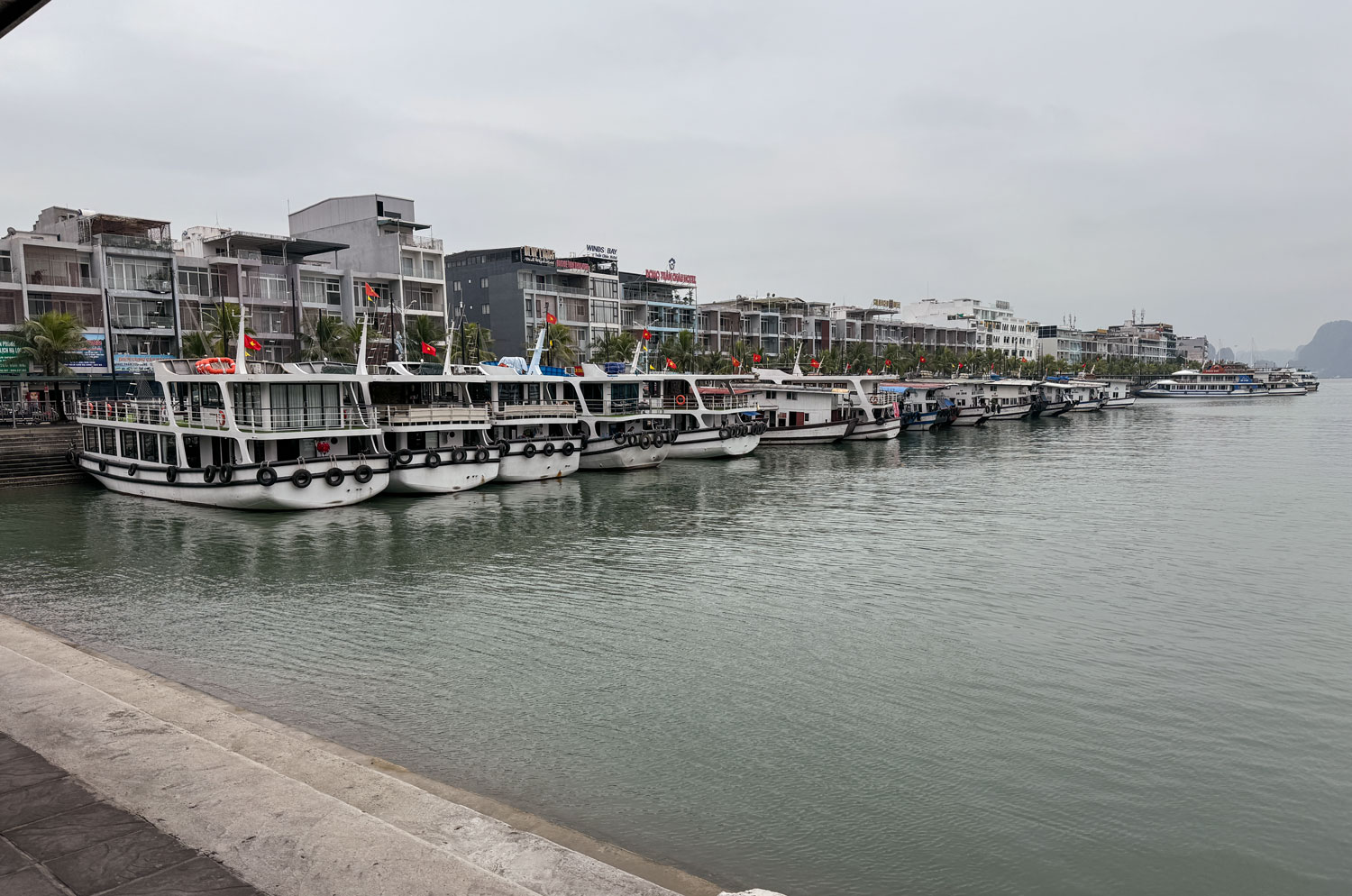
Here's the boat we will be taking. The woman on the right is the cook. Later, she also tried to sell us some pearls and other trinkets, but we weren't buying

When I made the reservation, they asked me if I wanted a standard boat or a luxury boat. I chose standard. But this boat was about as nice as a boat could be. I think the choice was just to see if they could get a bit more money from you - it would be the same boat either way.
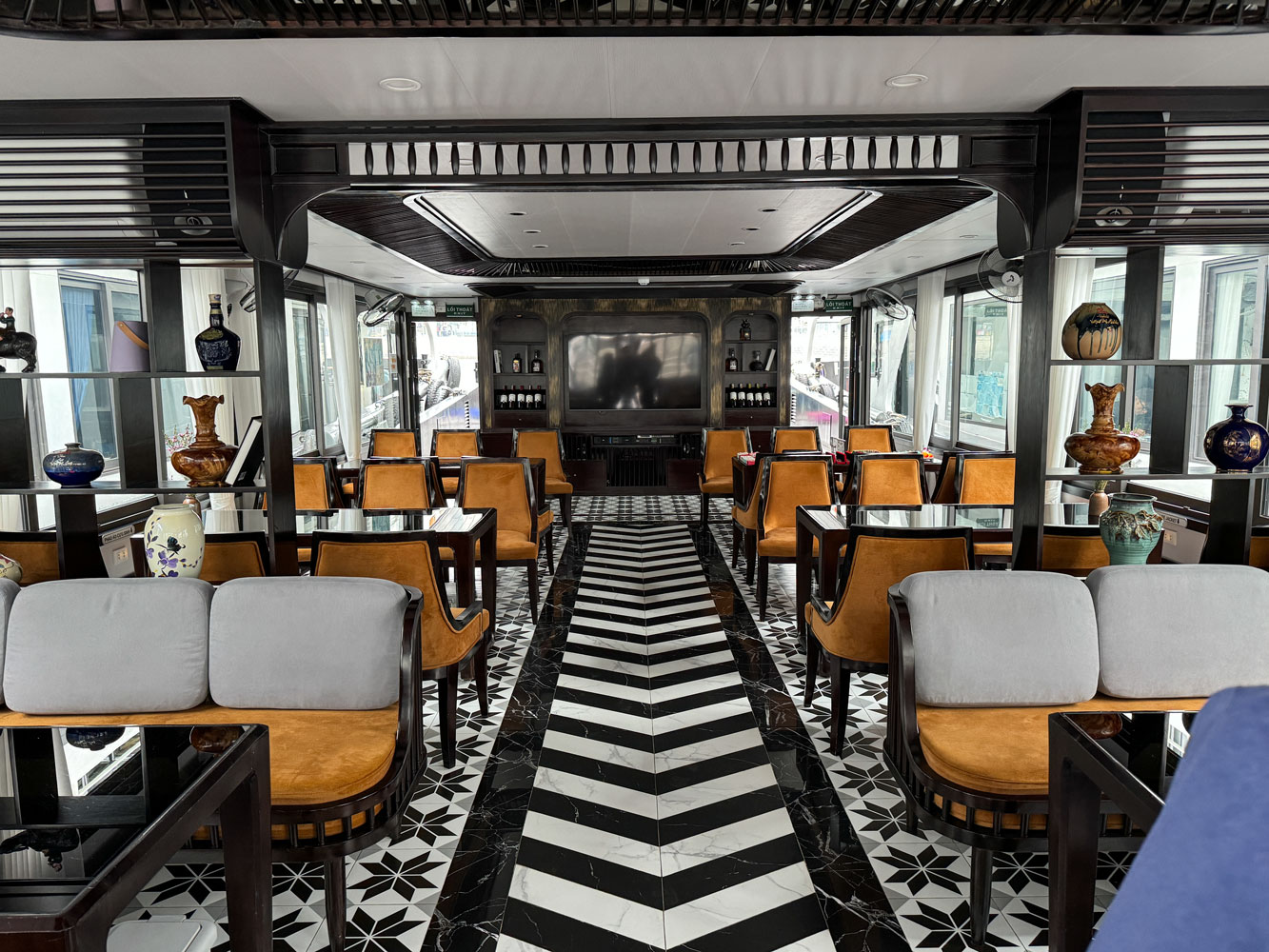
And, this boat was just for the three of us - amazing. We had a skipper, two deckhands, and the cook - more crew than passengers, if I don't count Hung, our tour guide.
We headed out into the bay. It was fairly cold on the water and there was a breeze blowing. You'll notice in some of the pictures that we're bundled up. There was also a lot of mist in the air, which turns the pictures blue and reduces the sharpness.

If you're interested in the geology of the bay, check this Wikipedia article, about half way down the page.
We're heading to Dau Go island, specifically the channel to the west side of the island. We sailed through that channel. There's an interesting cave on that island (Hang Dâu Gô - cave of Wooden Stakes) but we didn't visit it.

A picture of what we saw in the channel. I took a lot of pictures, but pictures can't really convey what it's like to be there.
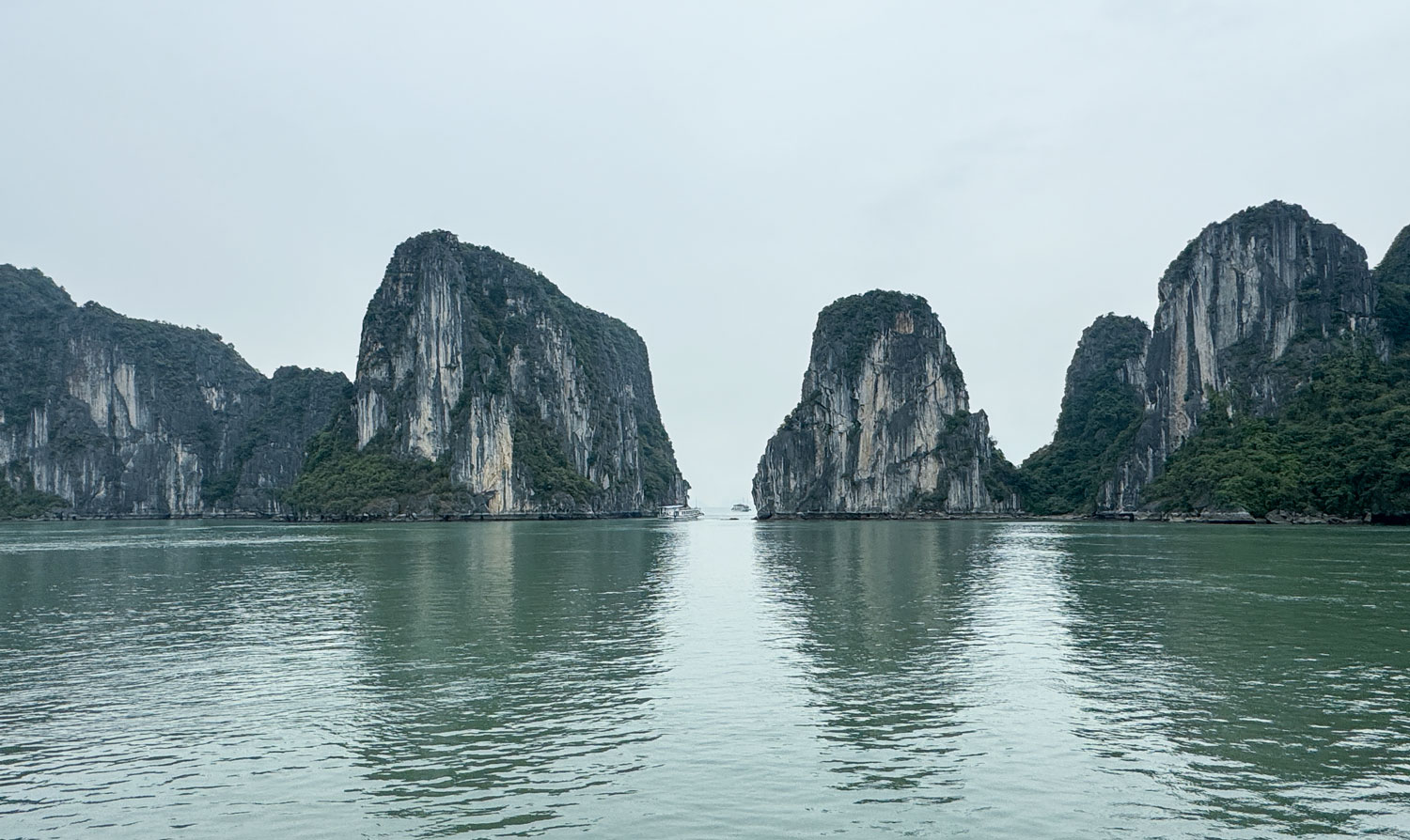
Hung kept wanting to take pictures of us - here's one. He had good photography skills.

They took us to the famous "kissing rocks", two rocks in the bay that, when viewed from just the right angle, appear to be touching.
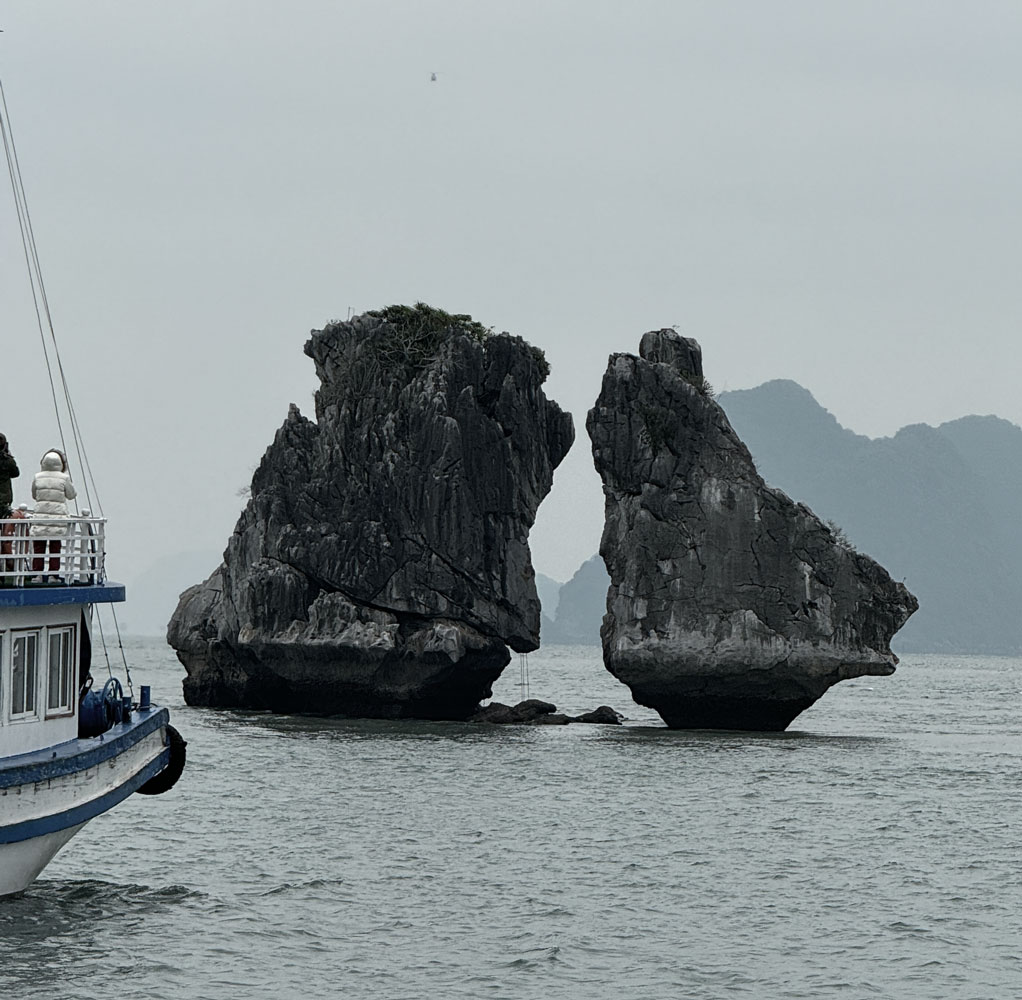

Very large cruise ships come to Ha Long Bay. This looks like the Celebrity Solstice. I assume they give tours with their tenders.

Next, we went to a cave area, Hang Sung Sôt, on Bo Hon Island. Hang Sung Sôt translates to "Cave of Surprises." A number of the islands in Ha Long Bay are hollow (have caves).
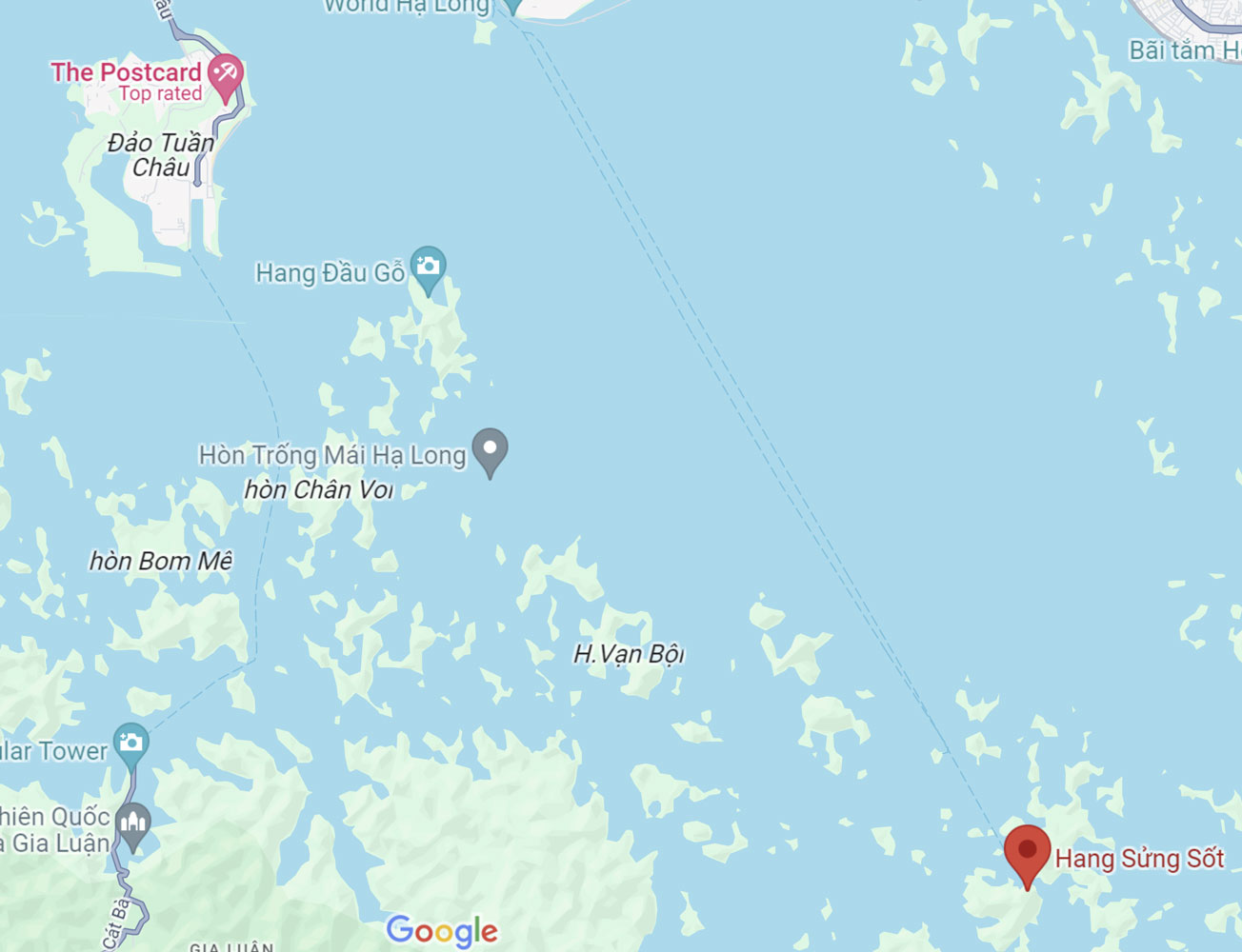
It's a path of about 100 steps to get up to the cave area, and there are multiple caves there.
Here's the landing area. The boat noses into the steps and you walk off. The ticket office is on the left side of the picture, and the largest cave can be seen in the upper right.
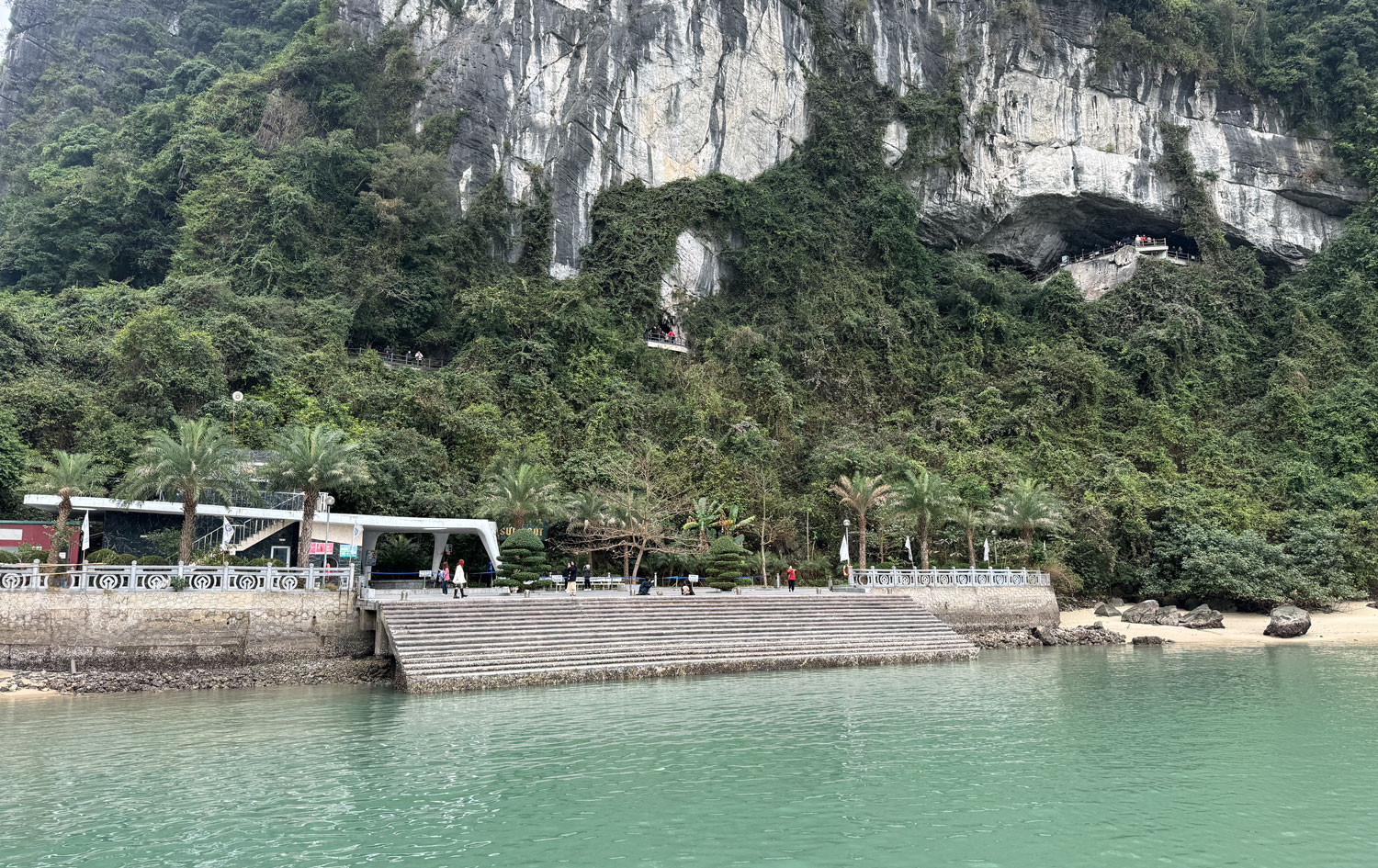
Judy and Jean wisely chose not to walk up to the cave, but we posed together for this picture . Hung and I went.
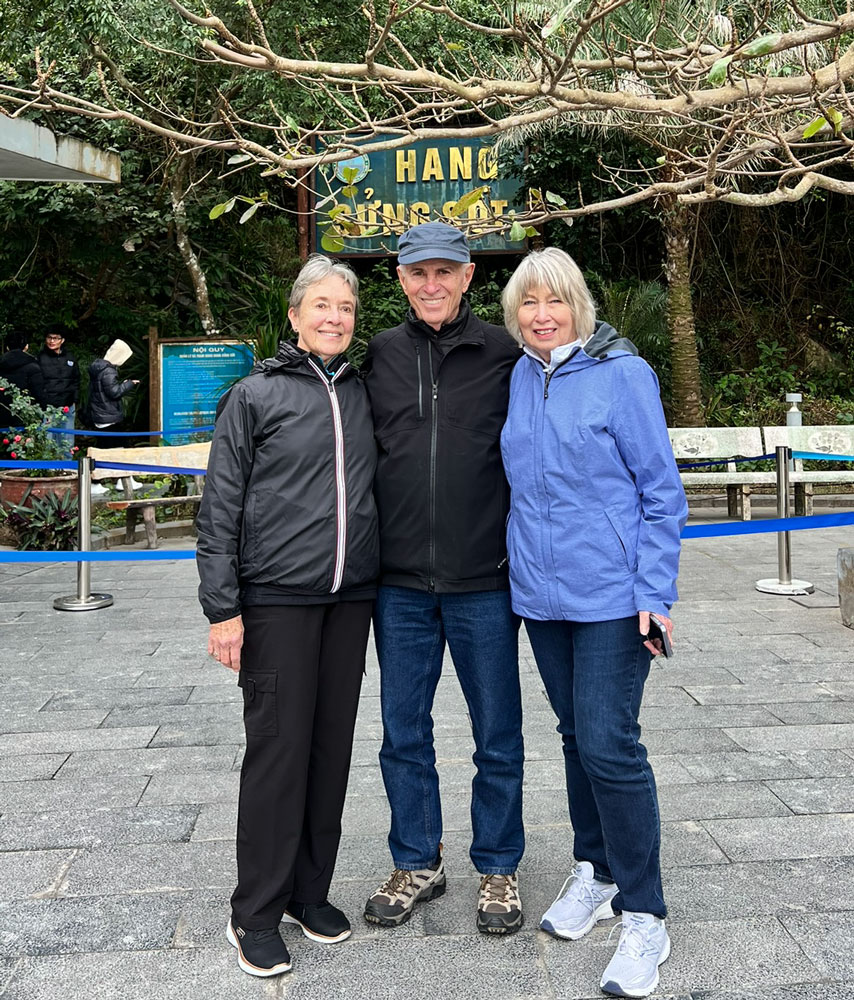
Here's where you start up the stairs.

And the first of the stairs.
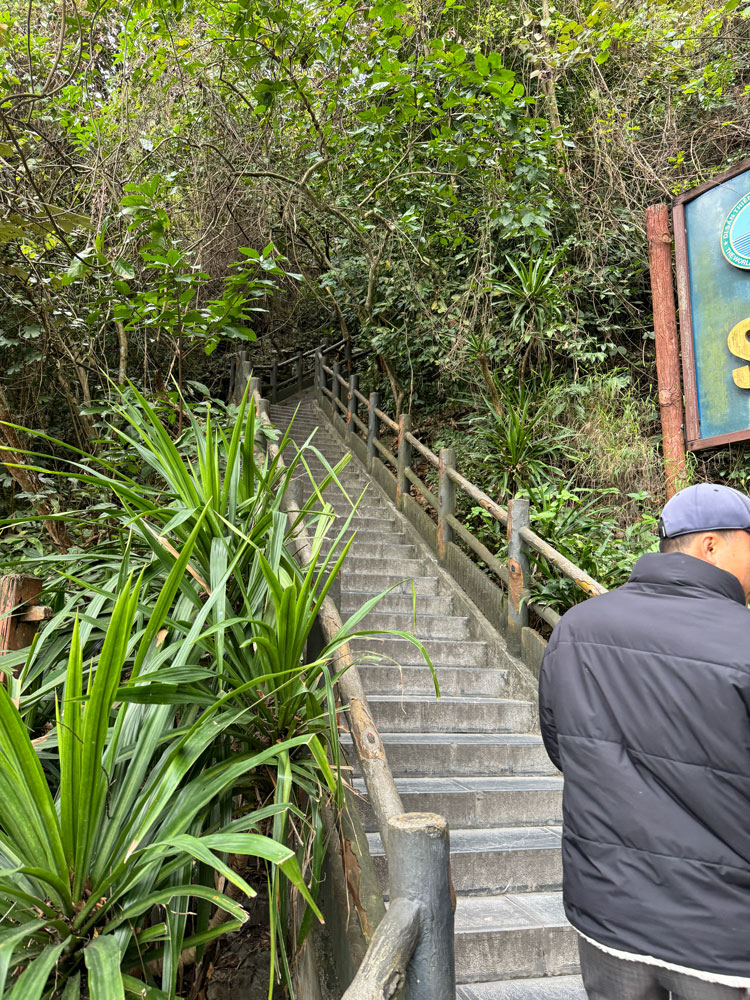
I'm in decent shape (but old), and I was soon huffing and puffing. I stopped at the first "landing" and took a picture back toward the landing area. The stairs were not steep but were tough- I don't think Judy could have made it.
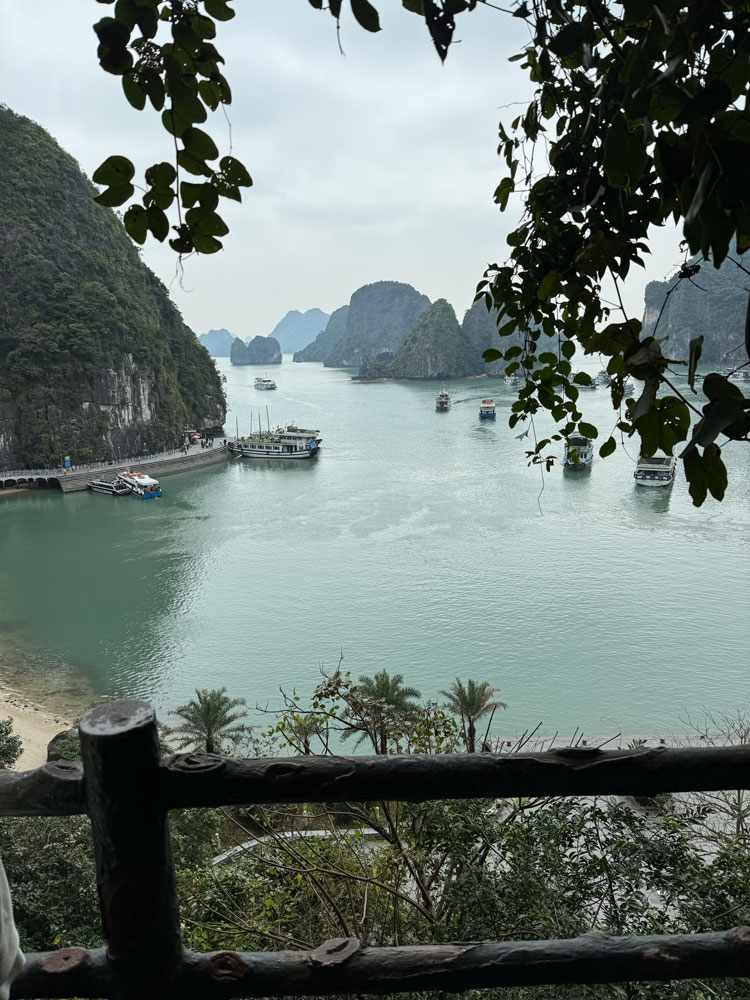
Then we continued to the first cave. You can see the steps at the right which lead to the second cave.
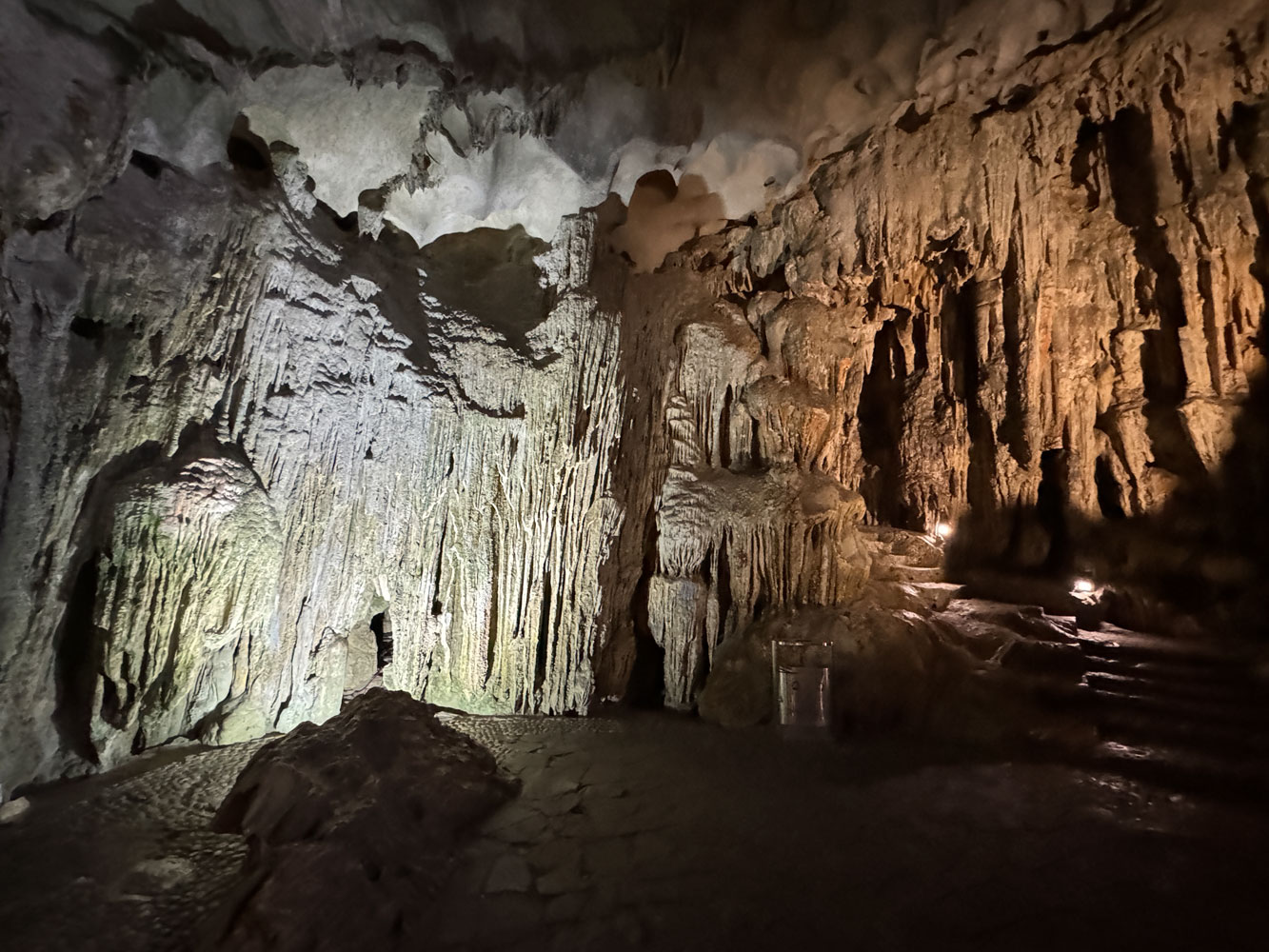
They had to cut a tunnel between the two caves.

Here's the second cave. You can see the steps leading to the next cave, about in the center of the picture.

Then we came to the third cave - and it is huge! This picture only shows a small part of the cavern.
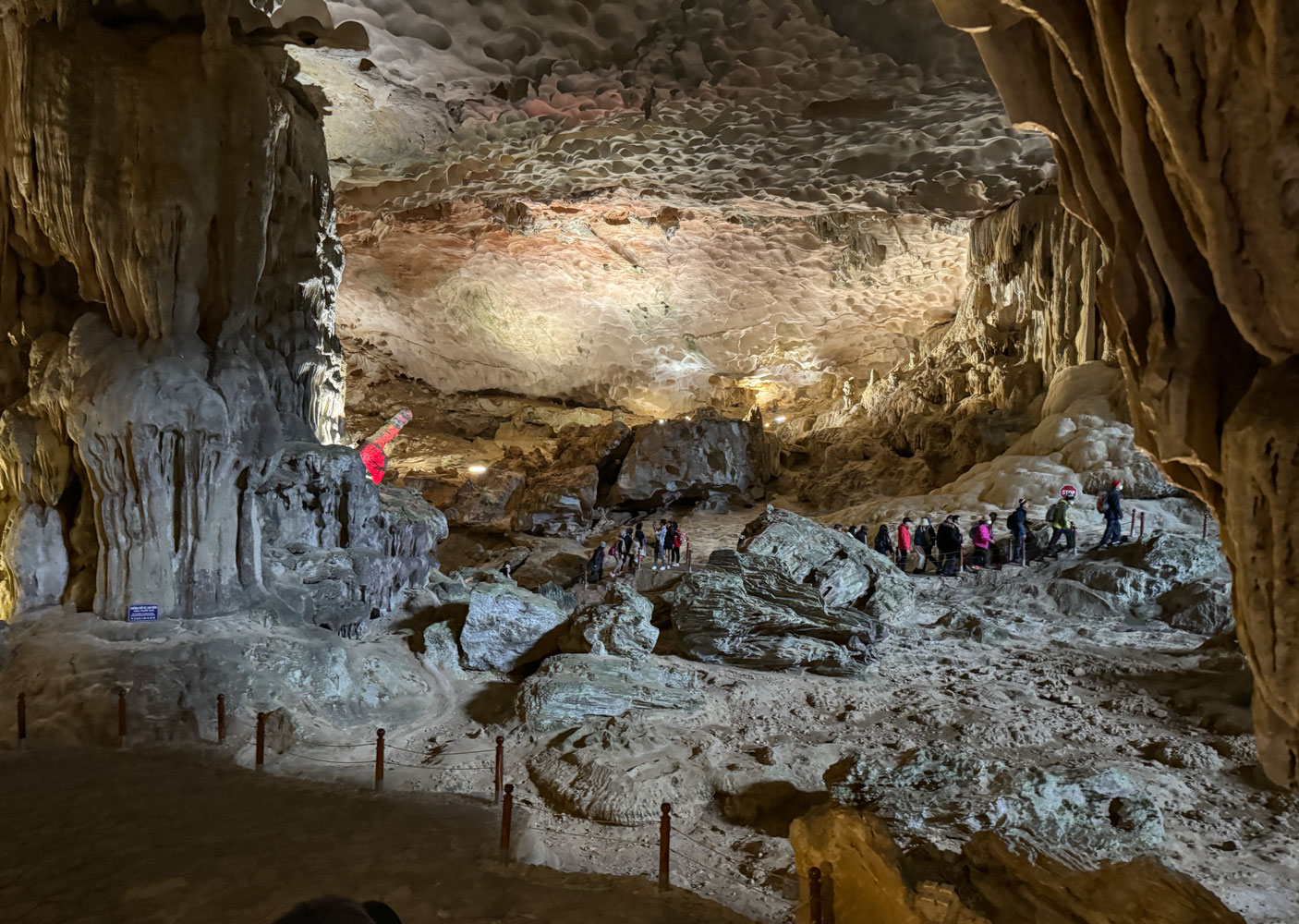
Notice how far back the walking path goes, It just goes on and on.

Notice how small the people appear in this photo. Gives you a sense of how big this part -and it's only part - of the cavern is.

A view further into the cavern.
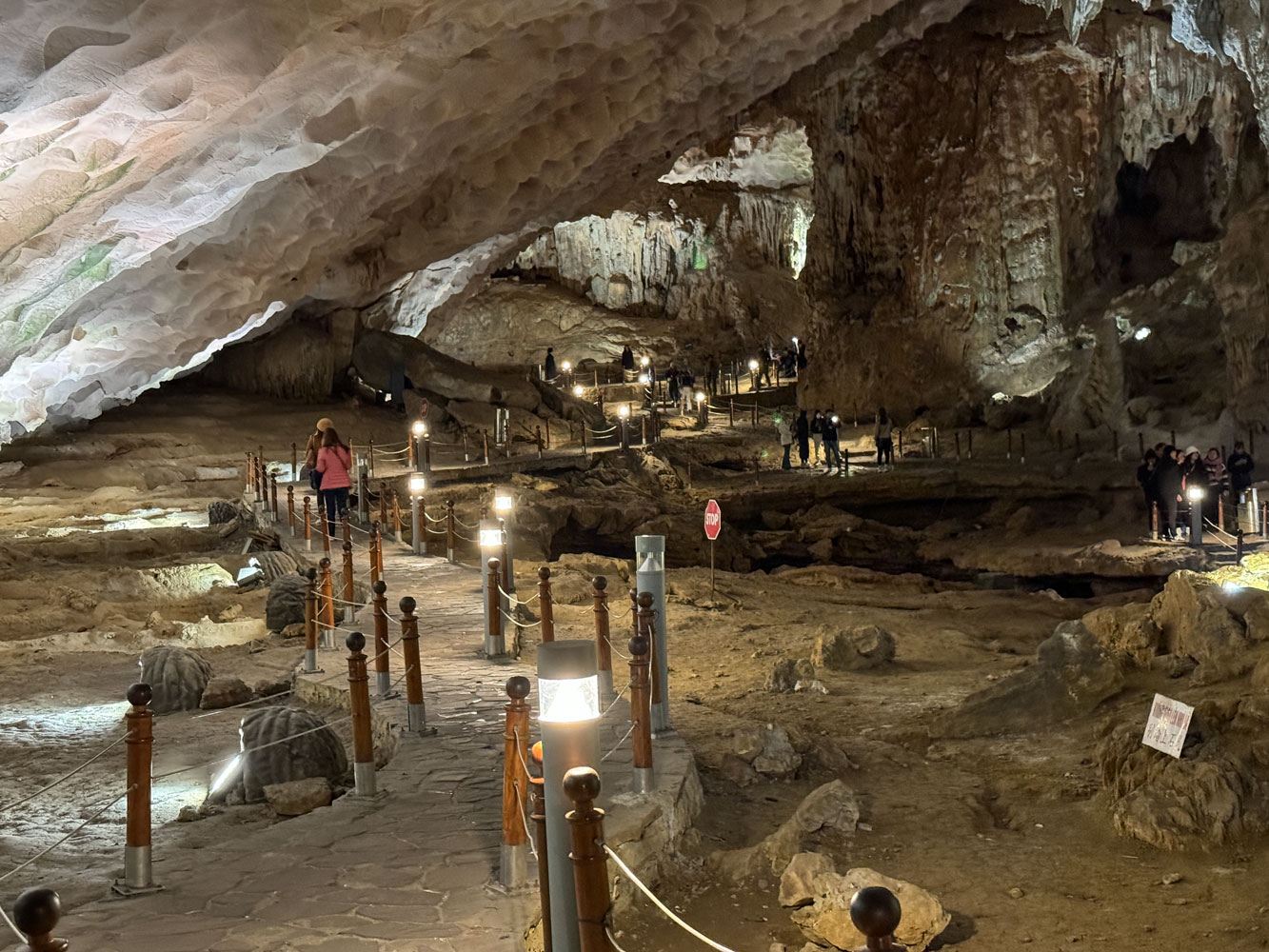
Hung took this picture of me at the end of the cavern, looking back.

Another couple of views showing how big this place is.

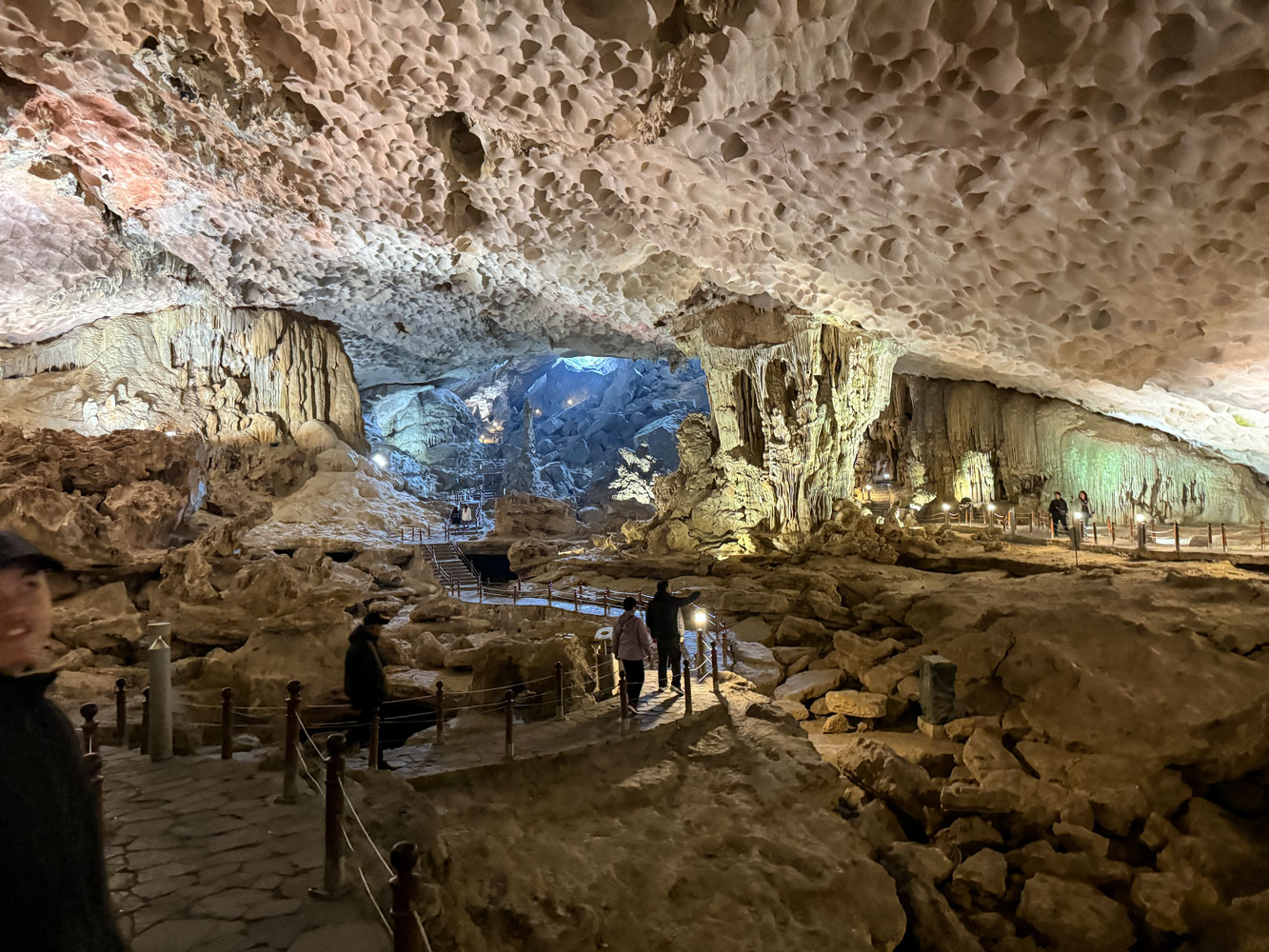
We can see the platform at the exit of the cave.
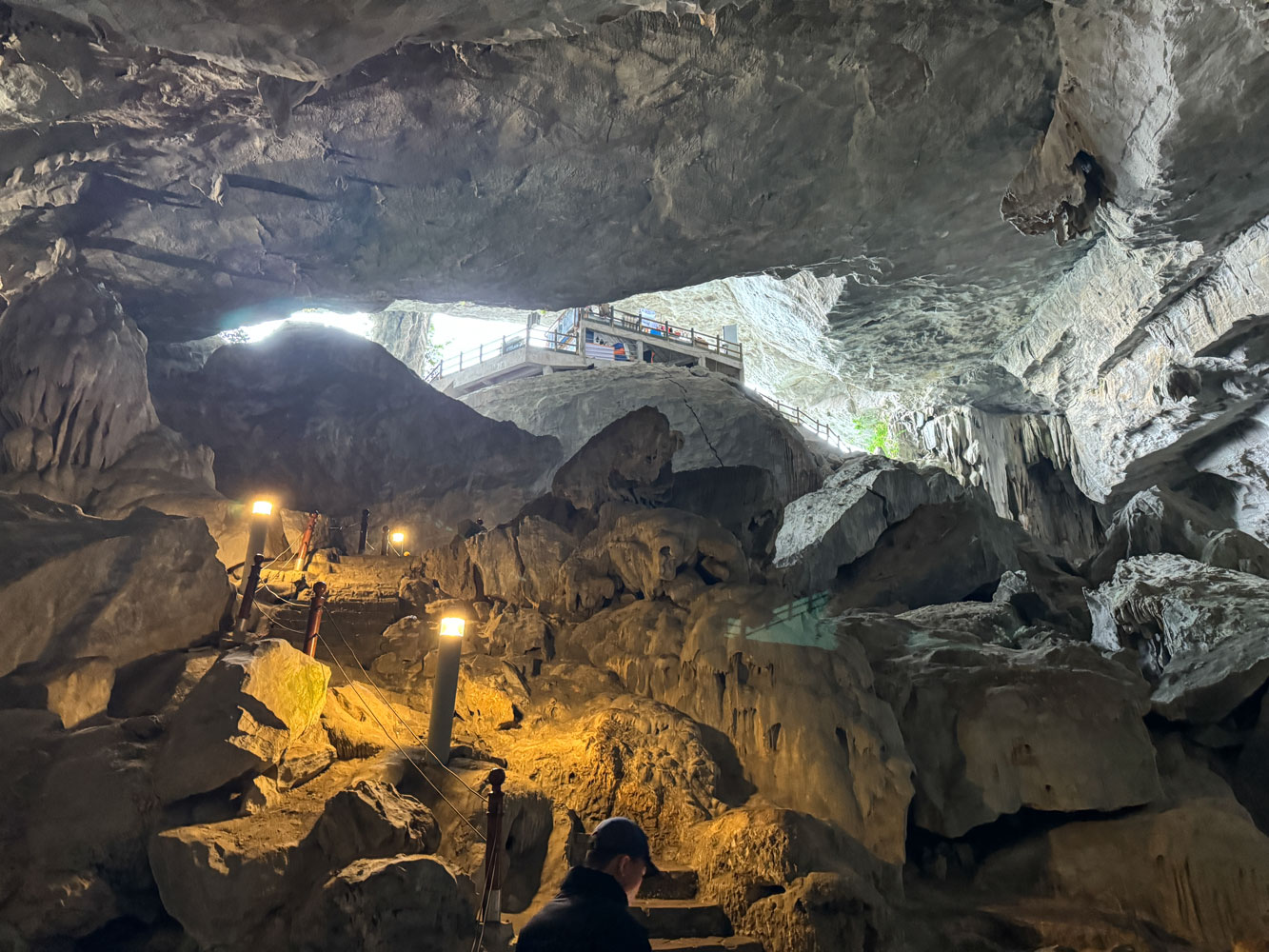
The view of the bay from that platform. You can see the boats docked on the left side of this picture. We now have to walk down to that area to get back on our boat.

Hung took this picture of me at the platform, but the background was too bright.

That was the end of our visit to the caves. We walked down the stairs to the area where the boats were moored, and took off for our next stop, Ti Top island, named for Soviet cosmonaut Gherman Titov.

This map shows the location of Ti Top island - it's very close to Bo Hon Island, where the Hang Sung Sot cavern is.
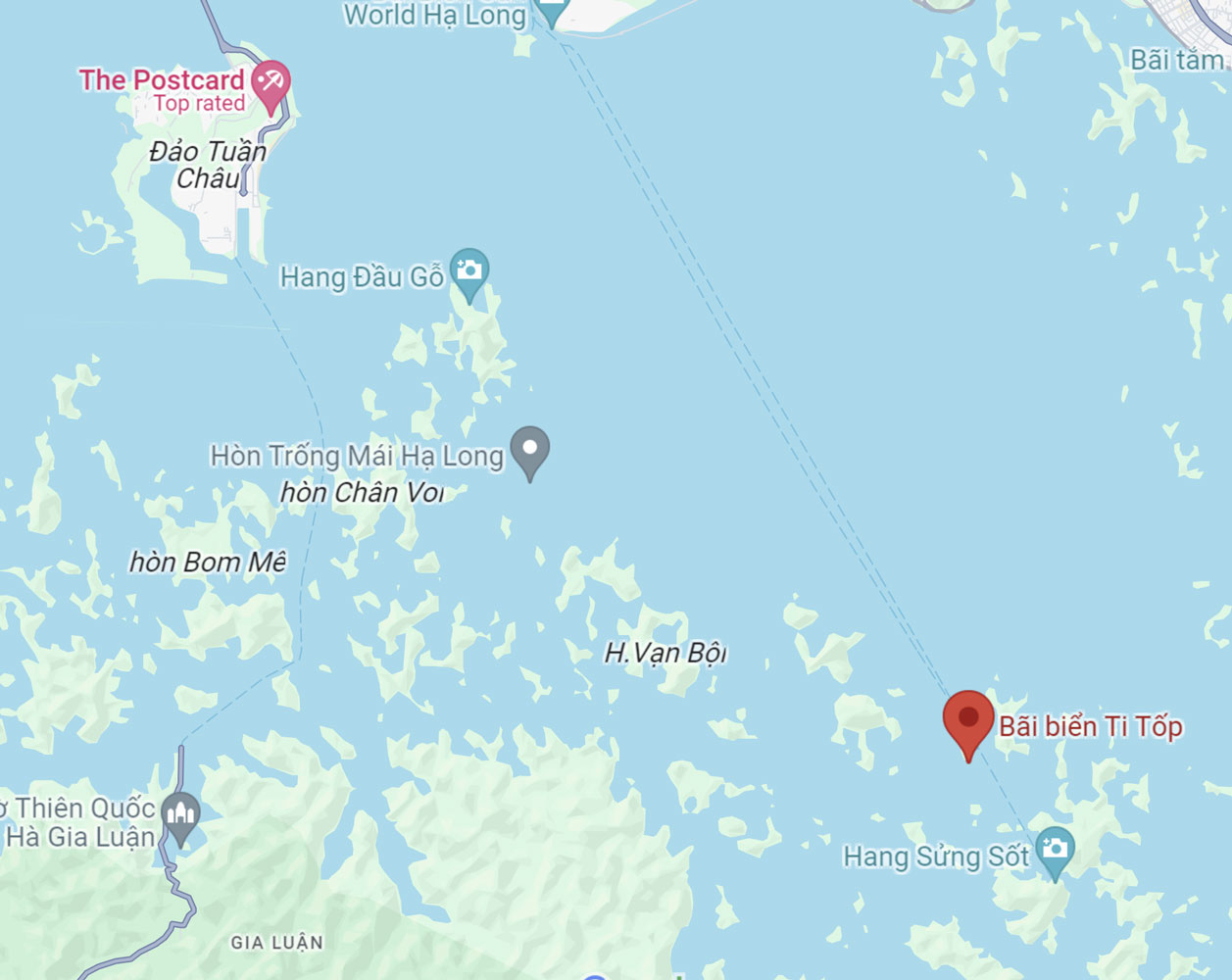
Here's a picture of Ti Top from the web. There's a lookout point on the top of the island, but it's about 400 steps to get to the top. Up and back is 800 steps, and none of us were ready for that.

Here's the entrance area.

Since we were not going to climb those steps, we just walked around the area and took some pictures.

And Hung took pictures of us. Here, in front of Soviet cosmonaut Gherman Titov.


Then it was back to the boat, and lunch.
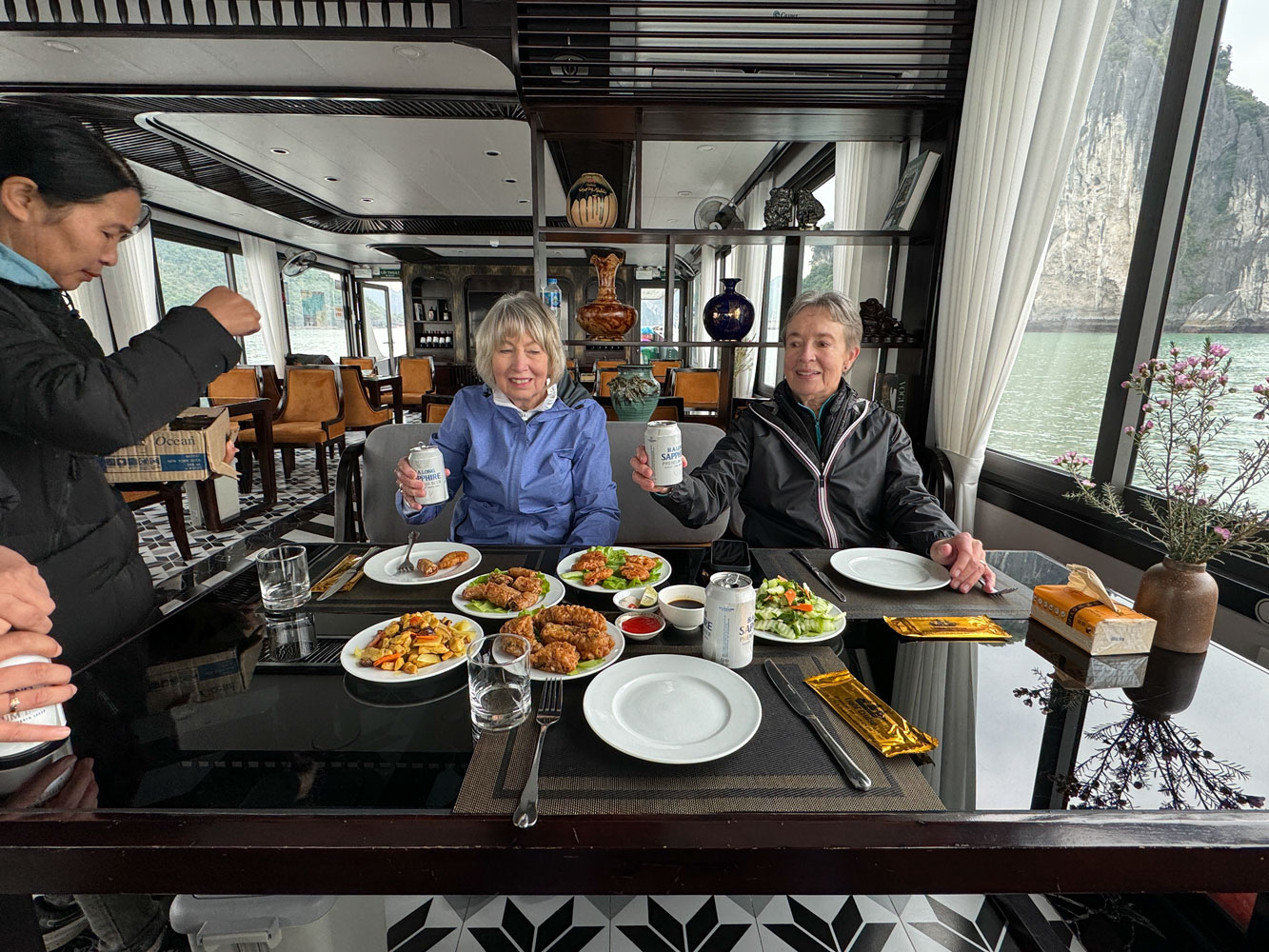
They offered us the opportunity to go Kayaking but we just didn't want to do that.
With that, we headed back to the harbor. I bought a Vietnam hat.

The trip back to Hanoi was uneventful. The driver must have been paid by the hour because, although the speed limit was 120km/hr. (about 75), he never went over 80km/hr. (about 50), and usually less.
As we were coming back into Hanoi, I took this picture of some of the housing. It's similar to the housing of Saigon back in 1970, but a bit nicer. I thought it was interesting that there's a new skyscraper in the background.

We got back to the hotel a bit after 4pm. Our next event is the Tauck Welcome Dinner at 6pm. We met our Tour Director, Jeff Bennett. While neither of us recognized each other immediately, we remembered that Jeff was shadowing Chris Morrison on our Morocco tour back in 2022.

It's a good group of 22 travelers. Over drinks, and then over dinner, we had a chance to begin getting to know each other. But it had been a long day and we headed back to the room after dinner.
++++++++++++++++++++++++++++++++
1/25/2024 (Thursday) This is our first day of touring. After breakfast, we met in the lobby and then boarded these golf cart type vehicles for a tour of the Hanoi Old Quarter.
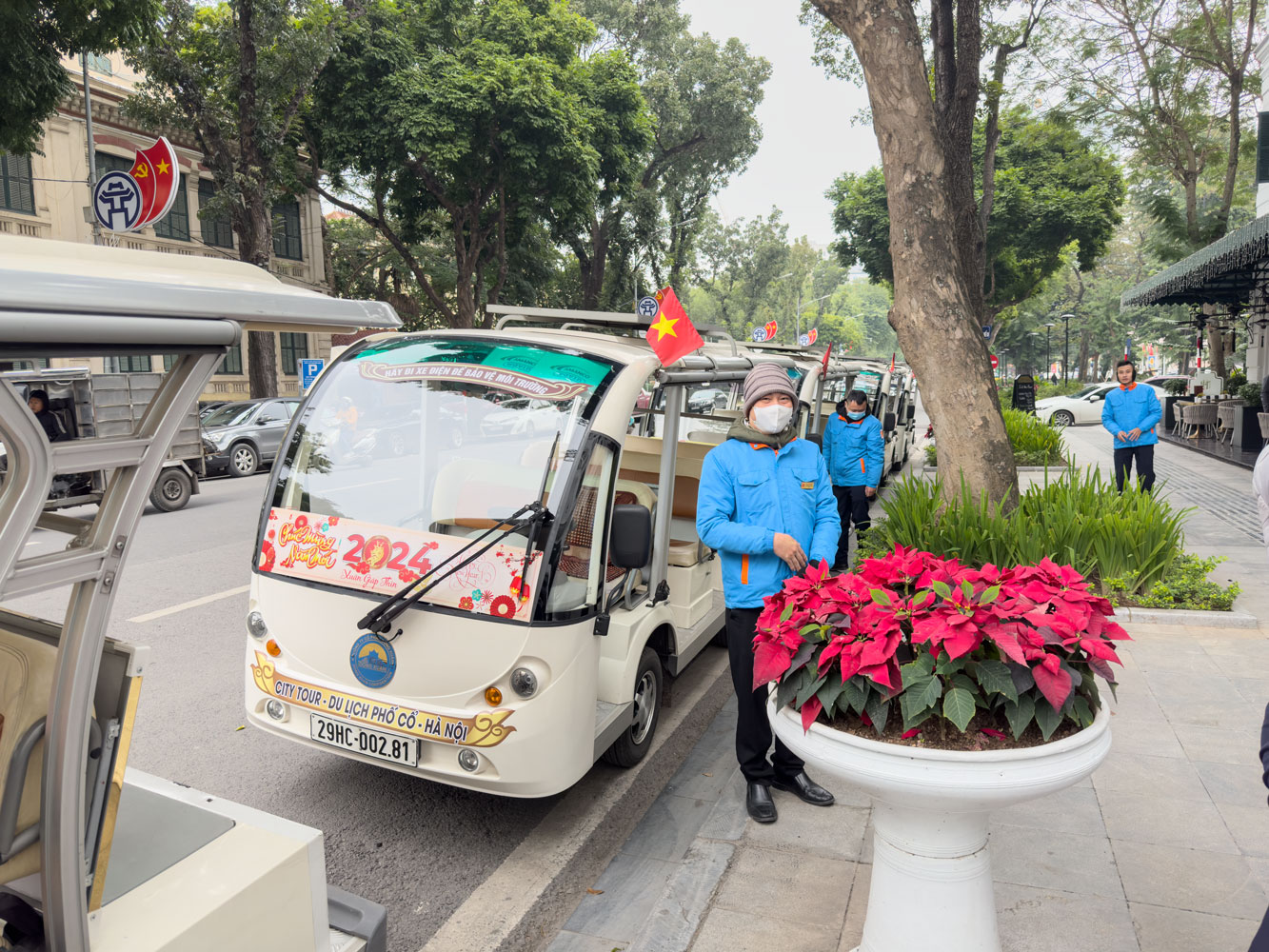
We headed out into the Hanoi traffic. I didn't get any really good pictures on this ride. Here's a view down one of the side streets.
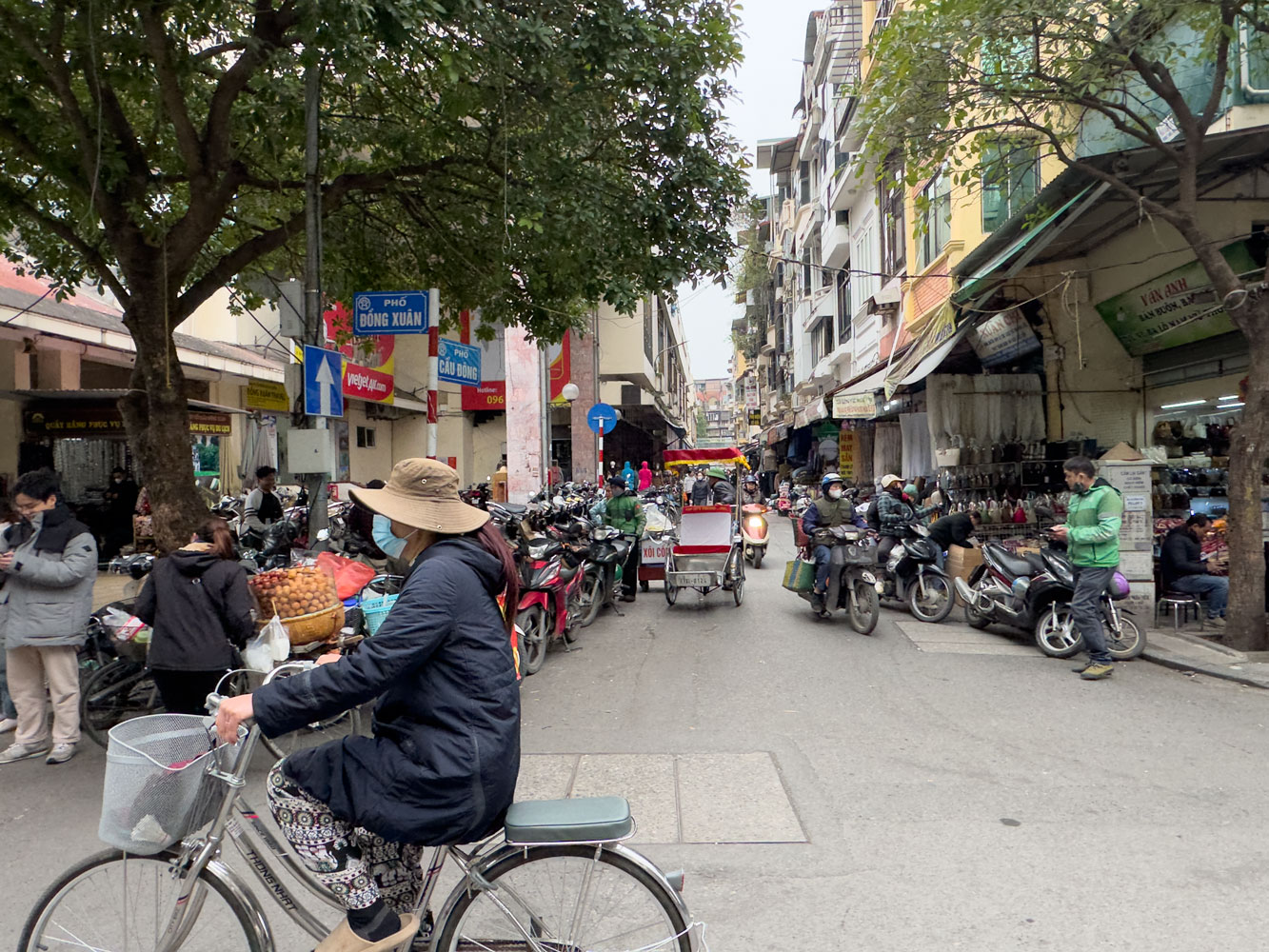
It was a fairly cool morning, as you can see, as we pulled next to one of the other golf carts.
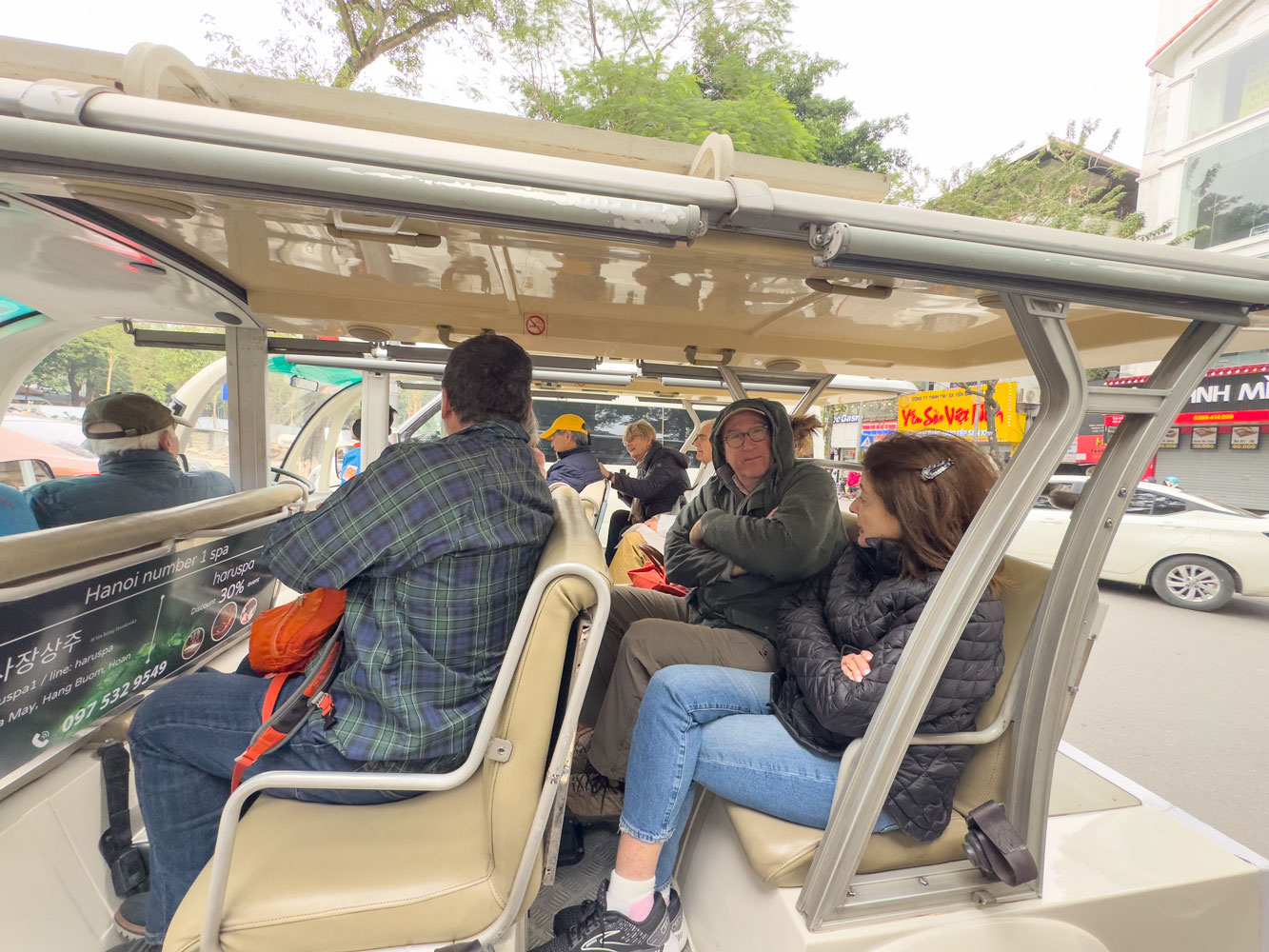
Têt is coming on February 10th and some of the stores had Têt decorations for sale.

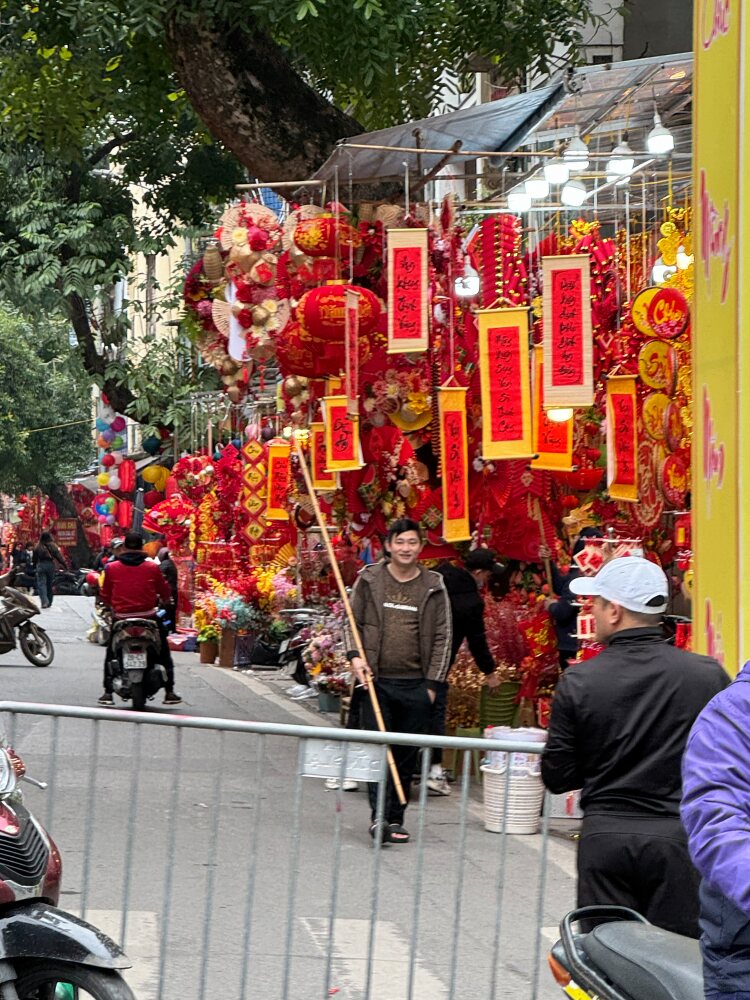
St. Joseph's Cathedral. Joseph is the patron saint of Vietnam.

After we returned to the hotel we had a few minutes before we boarded the bus to visit the notorious Hoa Lò Prison, known by the American POWs as the Hanoi Hilton.
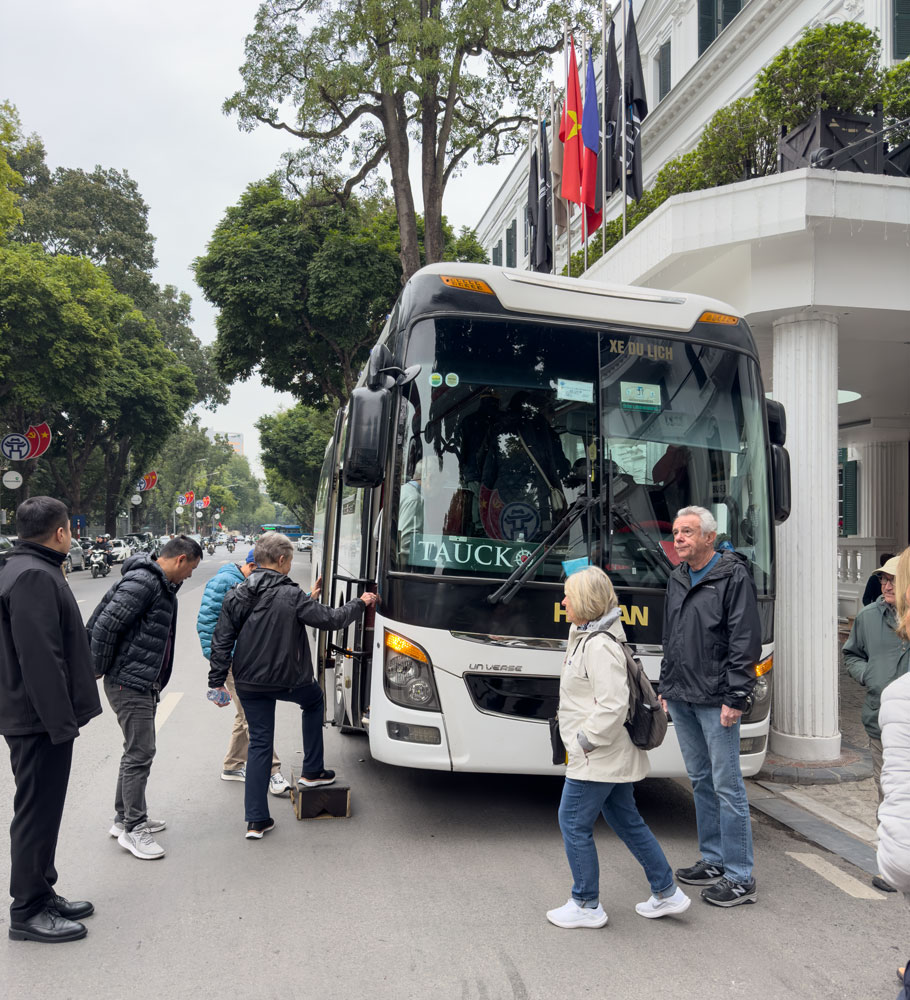
Here's a picture of the prison taken in 1970. Most of the prison has been demolished, leaving only the gatehouse as a museum, and that's what we visited.
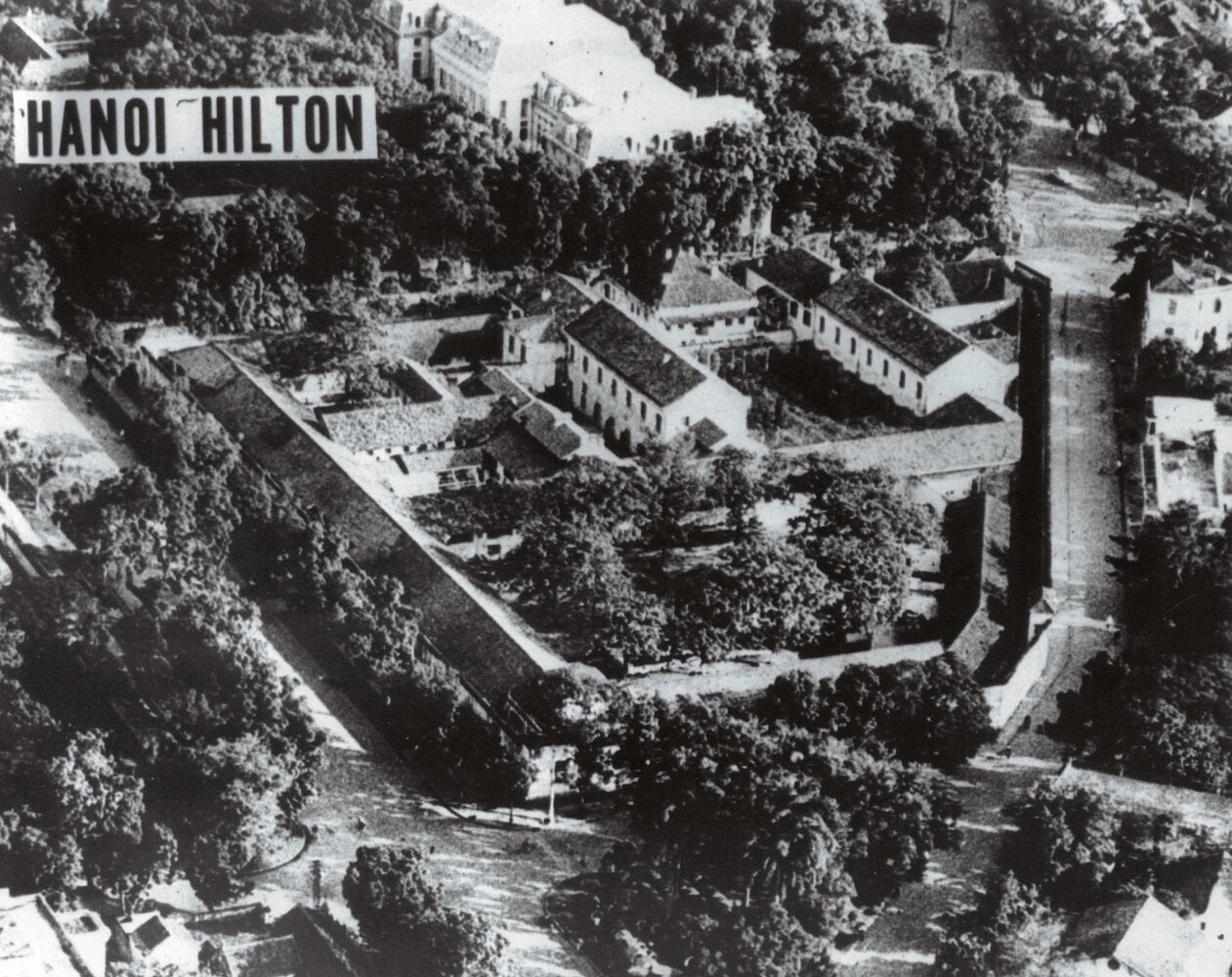
The prison was built by the French around 1900 and was used to incarcerate political prisoners. The French treated the prisoners terribly, including cruel torture and execution, and that's what the museum portrays.
After the French were defeated in 1954, the Vietnamese took over the prison and used it to incarcerate American pilots who were shot down. The Vietnamese subjected the pilots to miserable conditions, including poor food and unsanitary conditions.
Later, the pilots were subjected to severe torture methods, including being hung by ropes tied to their wrists behind their backs. This often dislocated their shoulders. The pilots were also subjected to beatings and solitary confinement in dark cells.
The museum ignores all of these facts and attempts to only portray the treatment of the Vietnamese by the French. When I asked the tour guide about the treatment of American prisoners, he would only say that they were treated well. Here's an article about the treatment of American POWs.
In general, the American Prisoners at the Hanoi Hilton maintained discipline and unity. When it came time for them to be released, they insisted that the first prisoners to be released were the sick and injured. Then, release was based on how long each prisoner had been incarcerated.
One of the original gates of the prison.
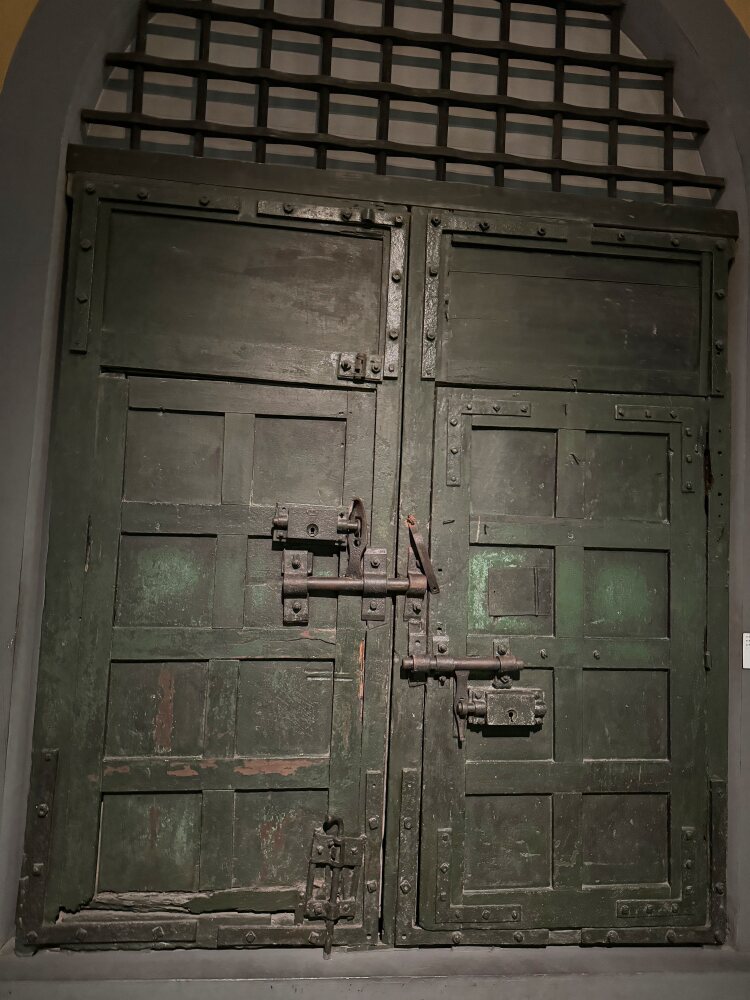
The guillotine used by the French for executions.
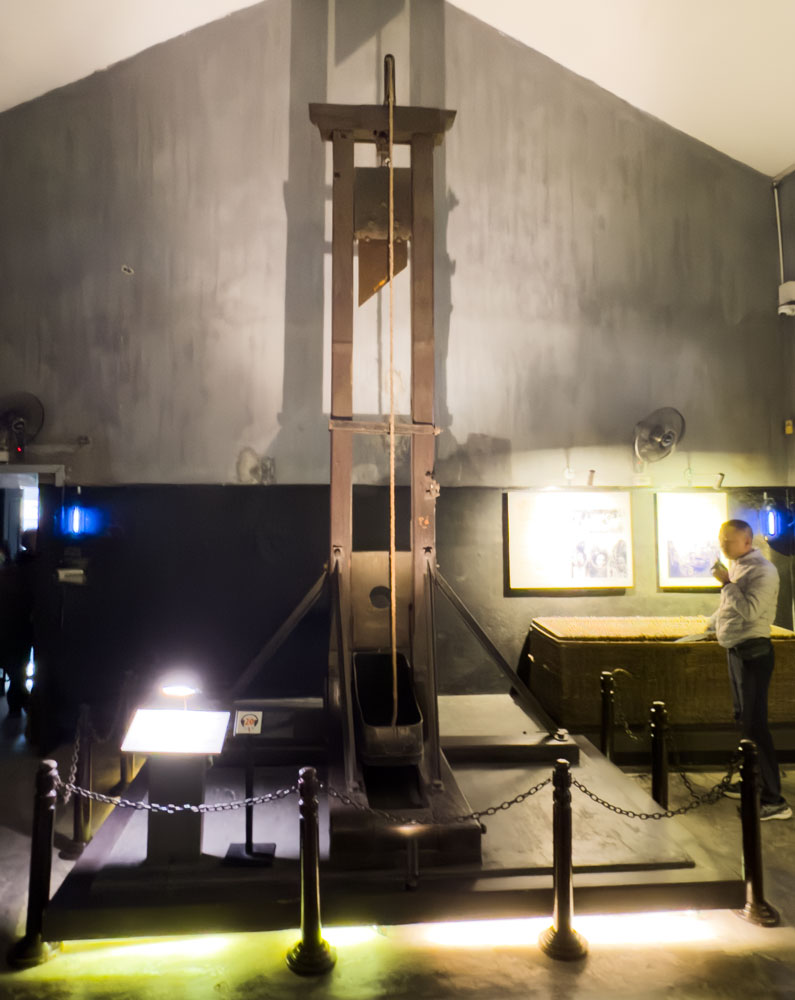
A memorial in a courtyard of the museum.

John McCain's flight suit. McCain was seriously injured when he ejected. The Vietnamese initially refused him medical treatment and only relented when they discovered that his father was an admiral.

The museum had this famous picture, Burst of Joy, by Slava Veder, depicting the return of Lt. Col Robert Stirm after six years in captivity. I include it, and the story behind it, to show the price paid by the POWs, not just their time in captivity but also on their return.
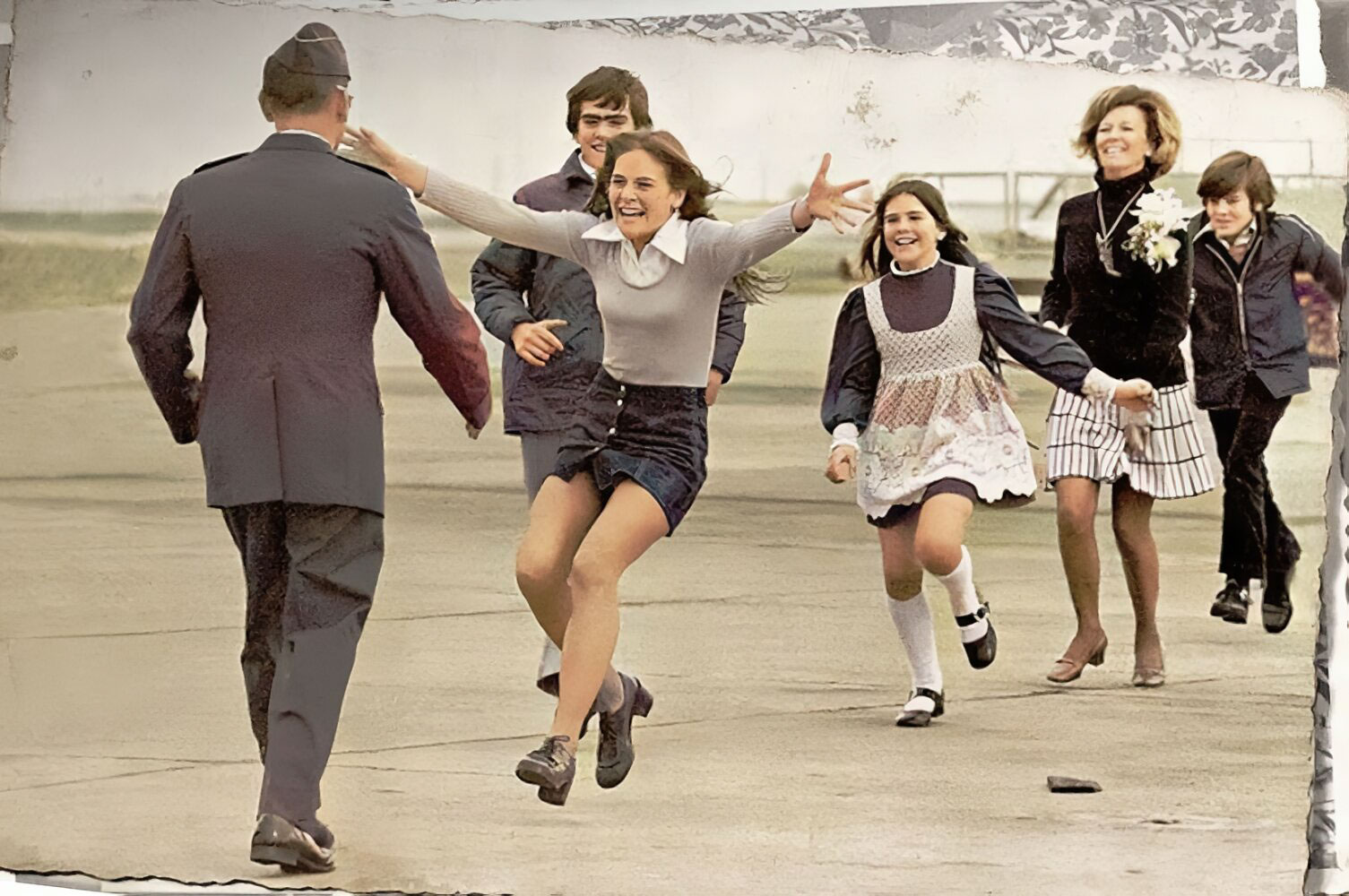
When Stirm got back to the US, he was given a letter from his wife saying she wanted a divorce. During most of those six years, she had been having affairs with other men. The military had been sending Lt. Col Stirm's pay to his wife while he was in prison.
In the divorce, his wife got 43% of his retirement pay. For more the story, see here.
After we left Hoa Lo Prison we drove to Truc Bach Lake. When John McCain was shot down over Hanoi, he ejected and landed in Truc Bach Lake.
The Vietnamese erected this monument to that event. McCain visited it when he came back to Vietnam, and his only complaint was the USAF (US Air Force) in the lower right side of the picture. McCain was a Naval aviator. Here's some of his story.
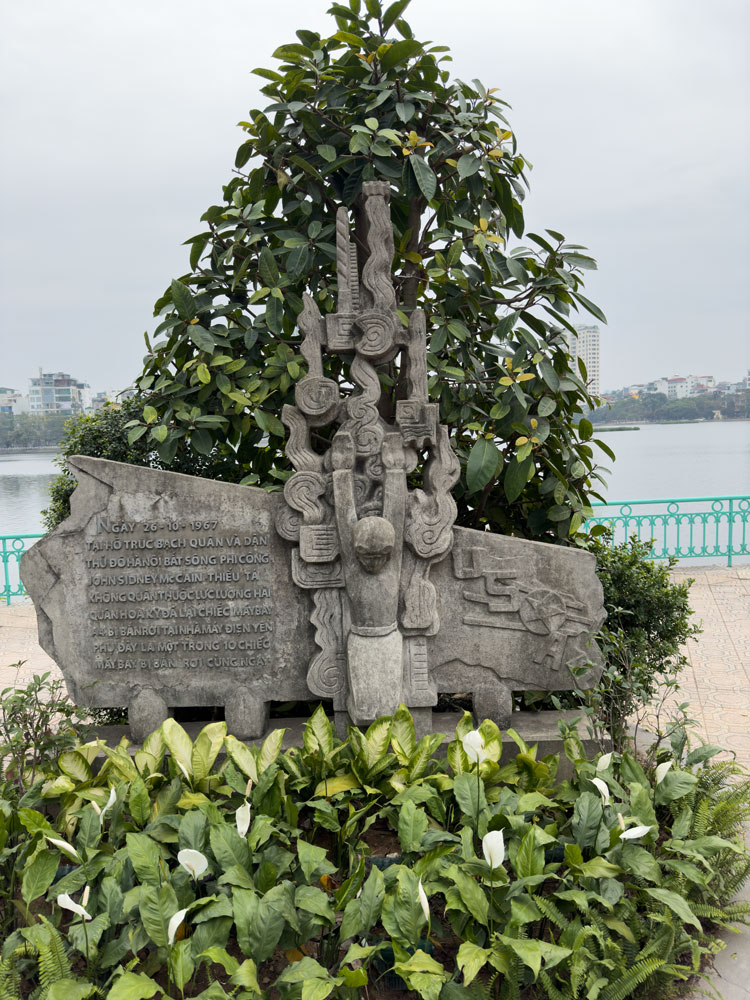
Our next stop was the Ho Chi Minh mausoleum. Incidentally, Ho Chi Minh lived in the United States from 1912 to 1913. There are stories that he worked as a baker at the Parker House Hotel in Boston, but the evidence is thin. London also claims Ho Chi Minh. Ho was in London between 1913 and 1919 and there are claims that he worked at the Carlton House during that time, but the evidence is also thin.

Here's a picture of the mausoleum.

We toured some of the mausoleum complex but there was nothing of real note. After that, we went to the One Pillar Pagoda.

A view from the side.
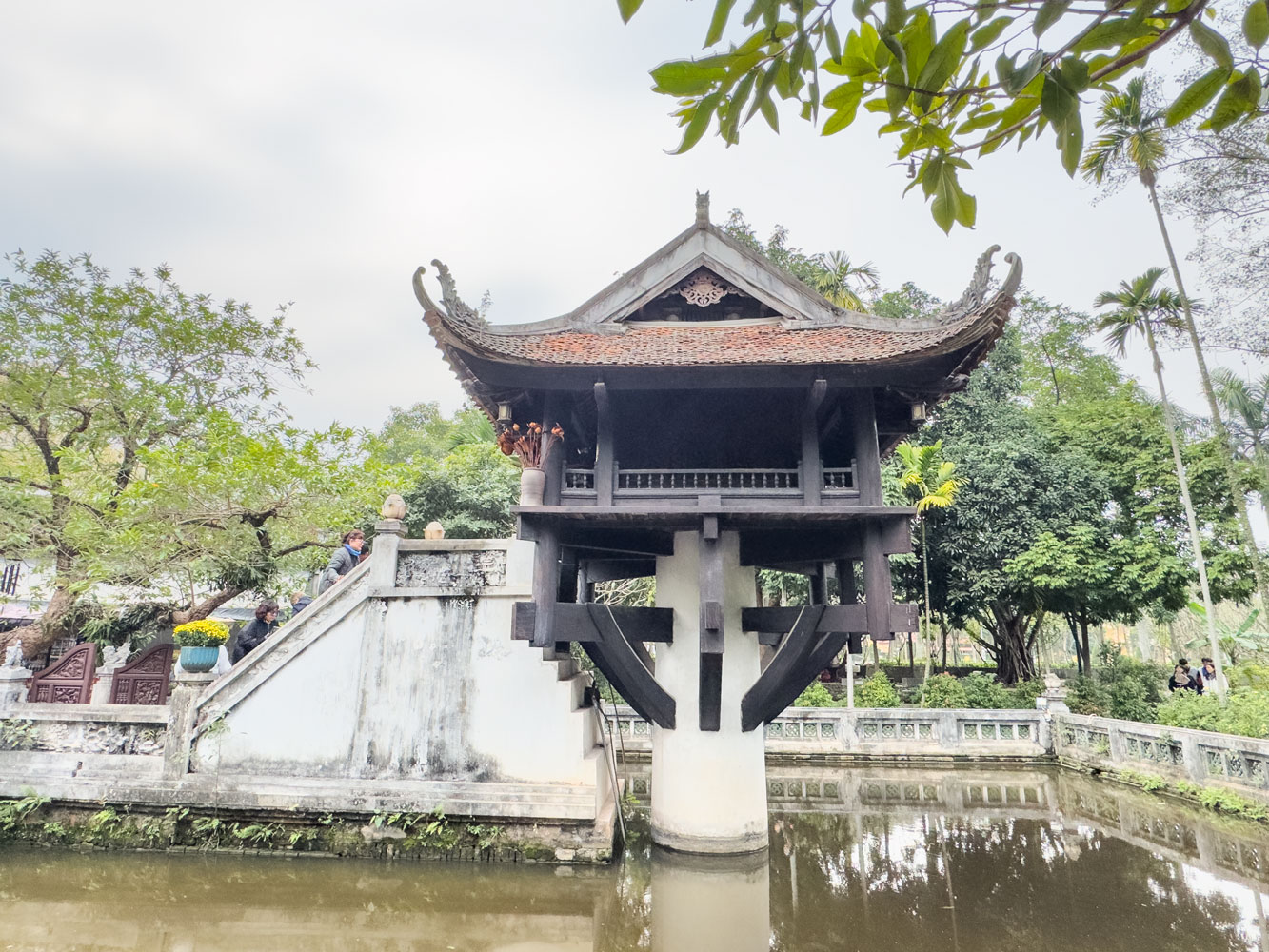
A view of the shrine in the main part of the pagoda.
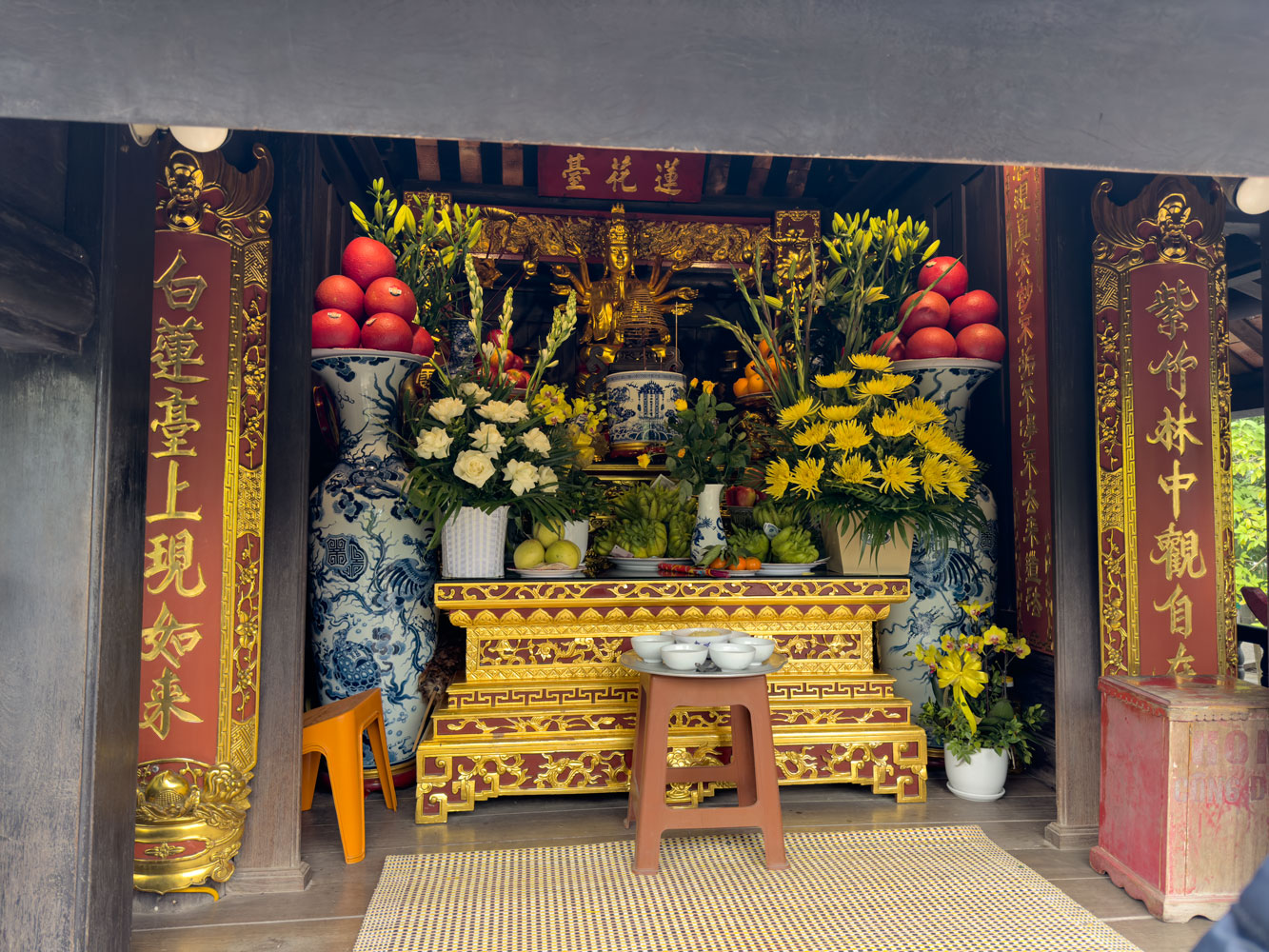
From here, we went to a water puppet show. The tradition of water puppets goes back a thousand years, when farmers would stage water puppet shows in the rice paddies after the harvest but when the paddies were flooded, perhaps by a recent strong rain. Here's a link to a site that gives some information about the origin of the puppet show.
The stories are based on folklore and legends passed down for generations. Unfortunately, western audience members will not be familiar with these stories - but they can still enjoy the show.
Here's the "stage" before the show. We had decent seats but a bit to the side. I had to take pictures around the head of the person in front of me.

The musicians sat on each side of the stage. In this picture, the woman in yellow appeared to be the leader and played a Vietnamese one-string instrument.

On the other side were the other musicians. Lighting was pretty bad so some of these pictures are not great.

This puppet started the show. Since we couldn't understand the language, it was difficult to know what was being represented.
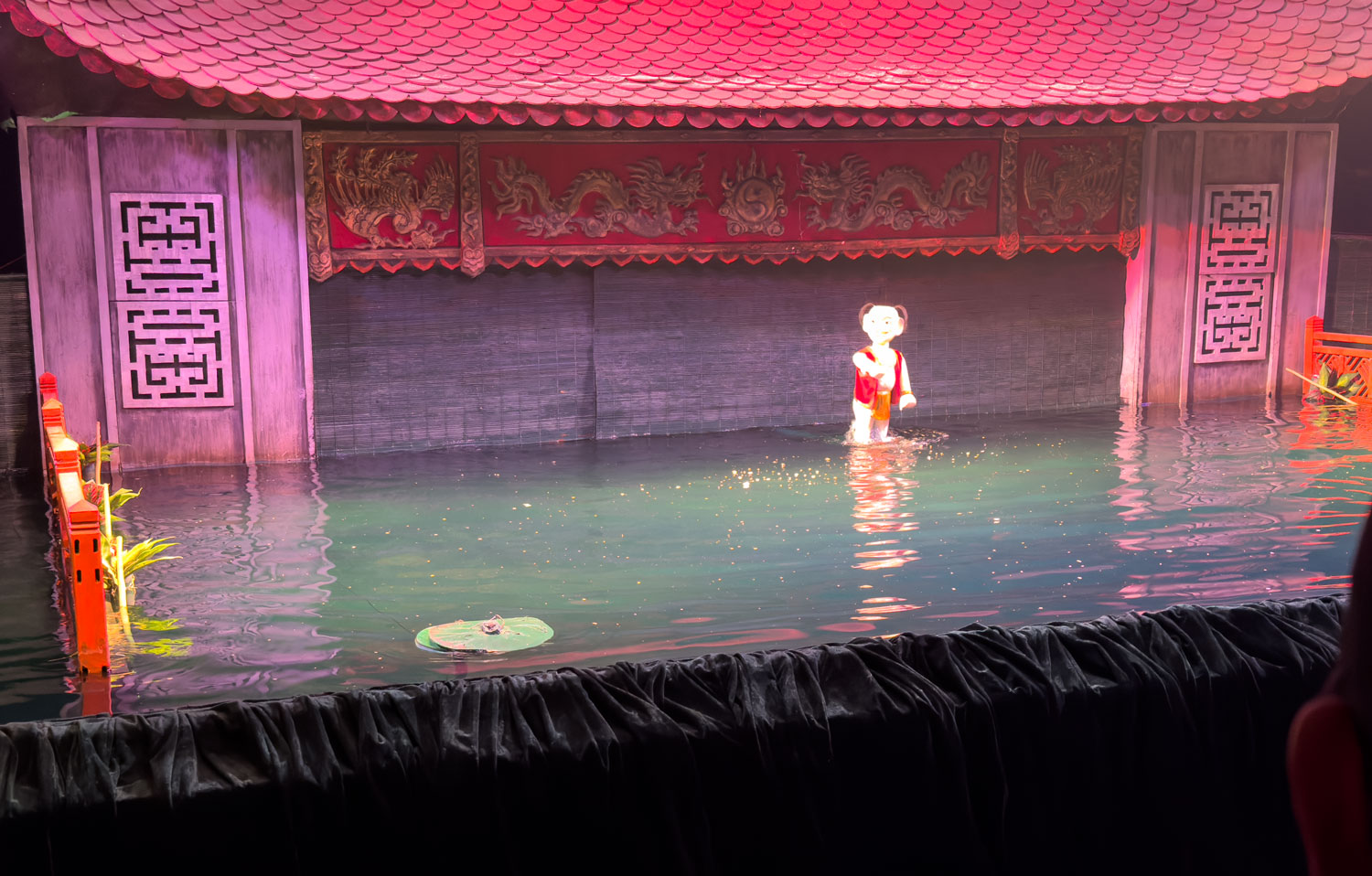
Then two dragons came out and spit fire at each other. This did make the theatre smoky for the later part of the show.

A puppet riding a water buffalo.

Farmers planting rice, with two water buffalos
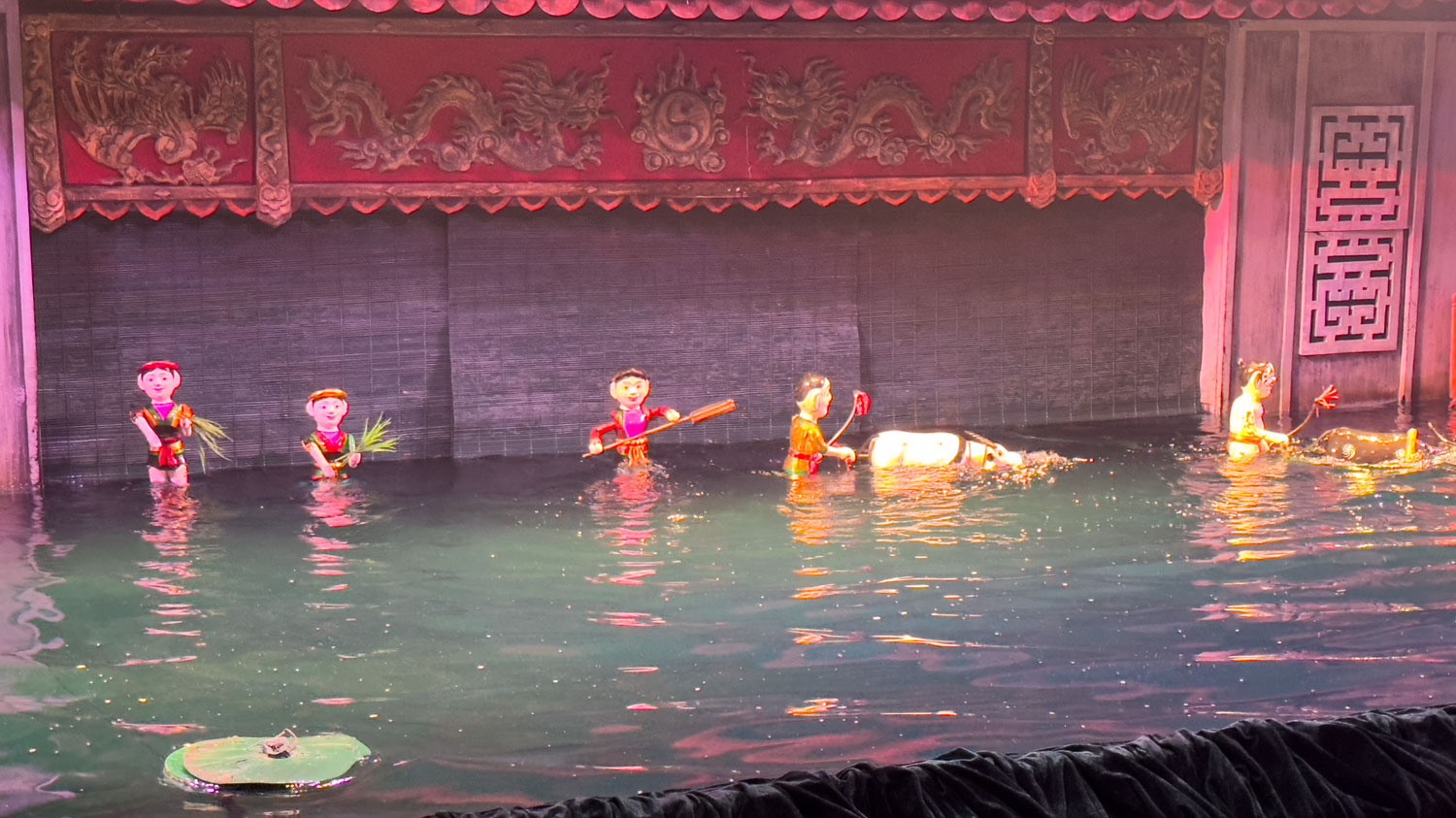
A number of figures came out of one door and paraded through the water, returning into the door on the other side. These were obviously not puppets, but just figures in a "train" following a track under the water.

Here they are going into the door on the other side of the stage.
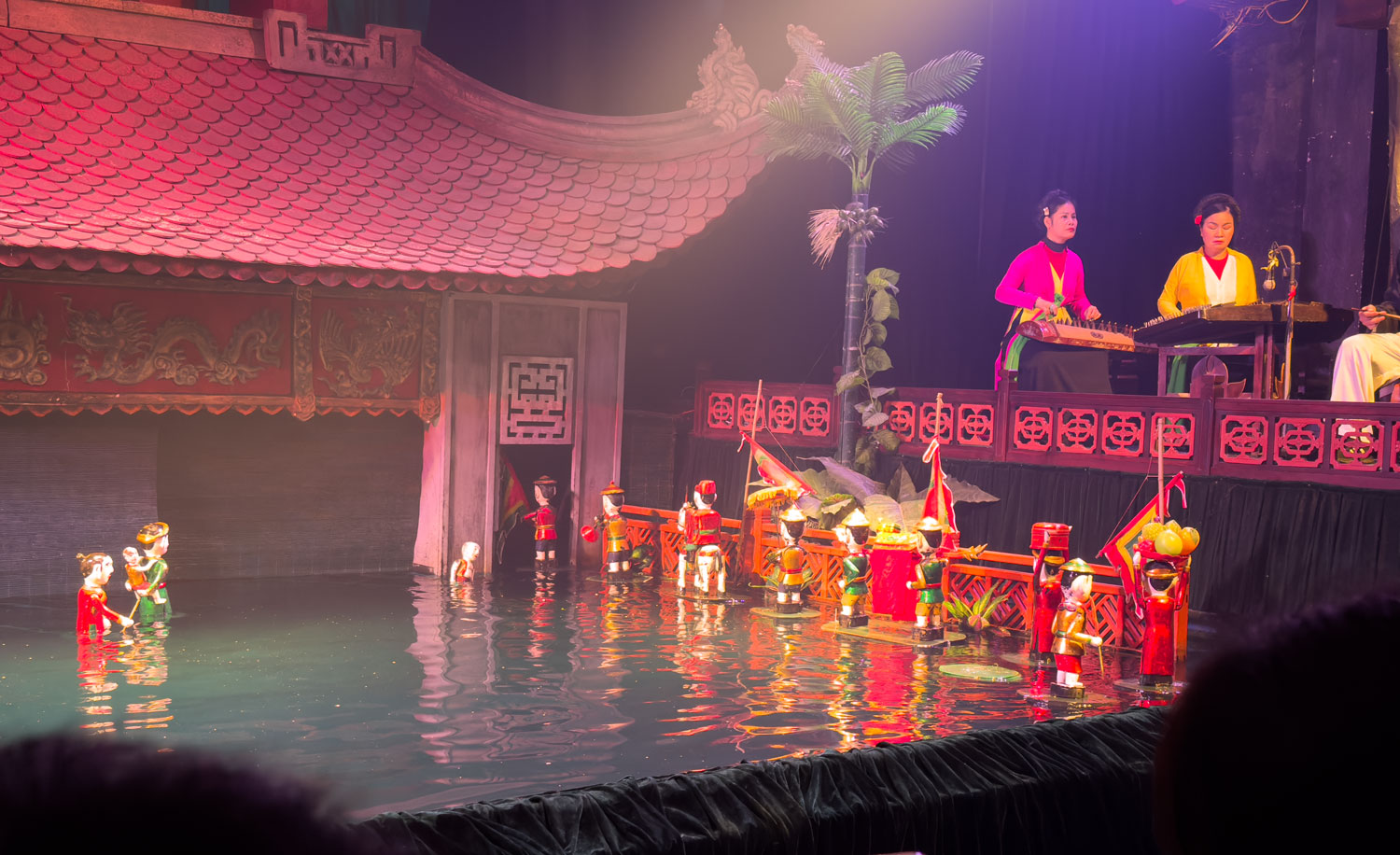
I'm not sure what this puppet represents.
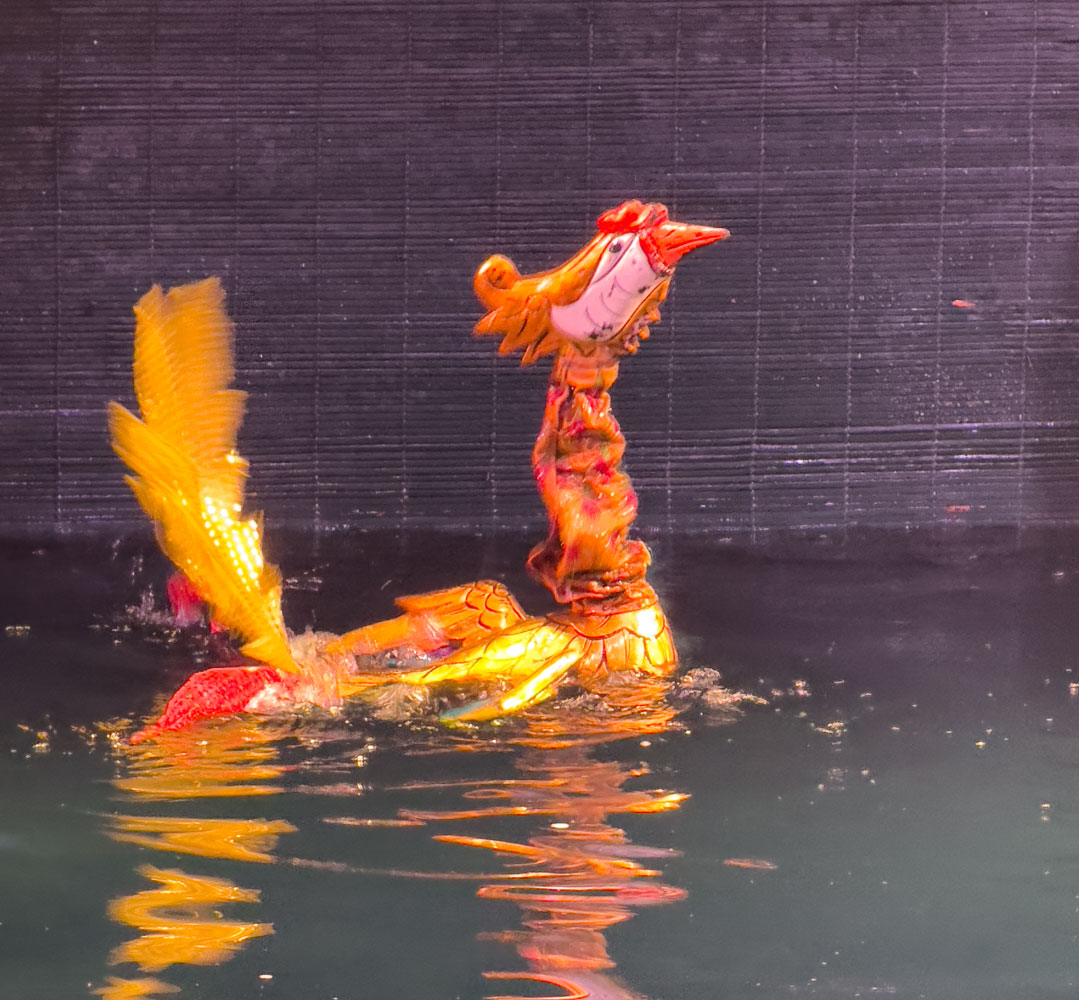
I have many more pictures of the puppet show, but I have to stop somewhere. Eventually, the puppeteers came out and took a bow.
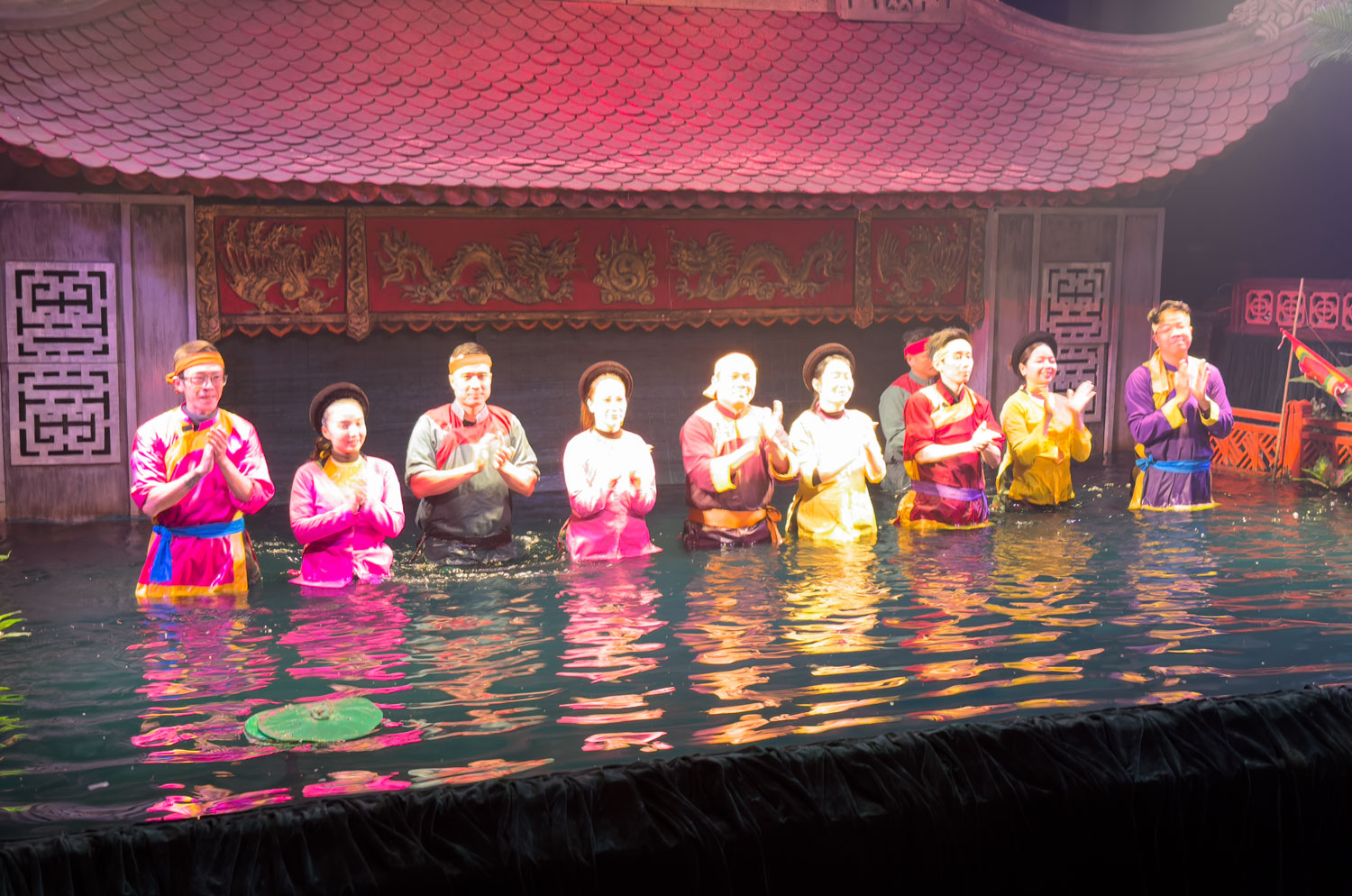
We headed back to the hotel after the show.
At 6pm we had a reservation for a tour of the bunker (or bomb shelter) at the hotel. Apparently, the hotel built the bunker early in the war (the war with the Americans) in order to provide a place for high-value guests to shelter during a bombing raid.
After the war, the bunker was forgotten, and only re-discovered recently during the renovation of the old portion of the hotel.
Here's the entrance to the bunker.
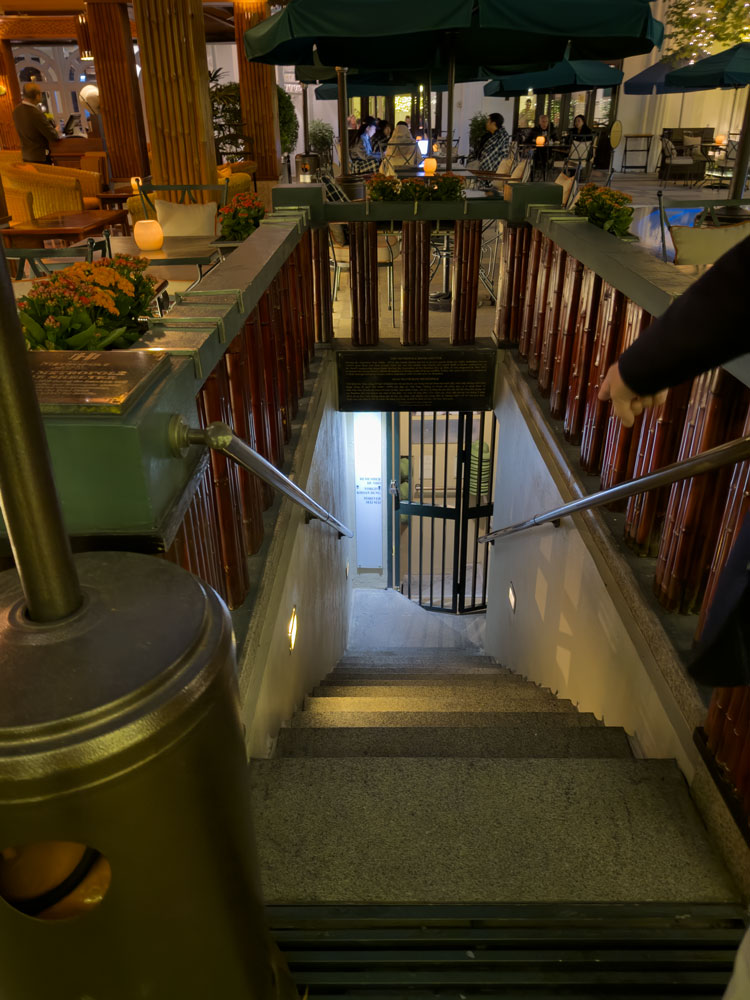
Our guide talking to us while in the bunker. If I recall, he said the bunker had six rooms. It was divided that way to allow additional support to the ceiling by the walls, and to perhaps allow some to survive if the bunker received a direct hit by a bomb.

One of the rooms. The ceiling is six feet thick, but made of layers of concrete and soil.
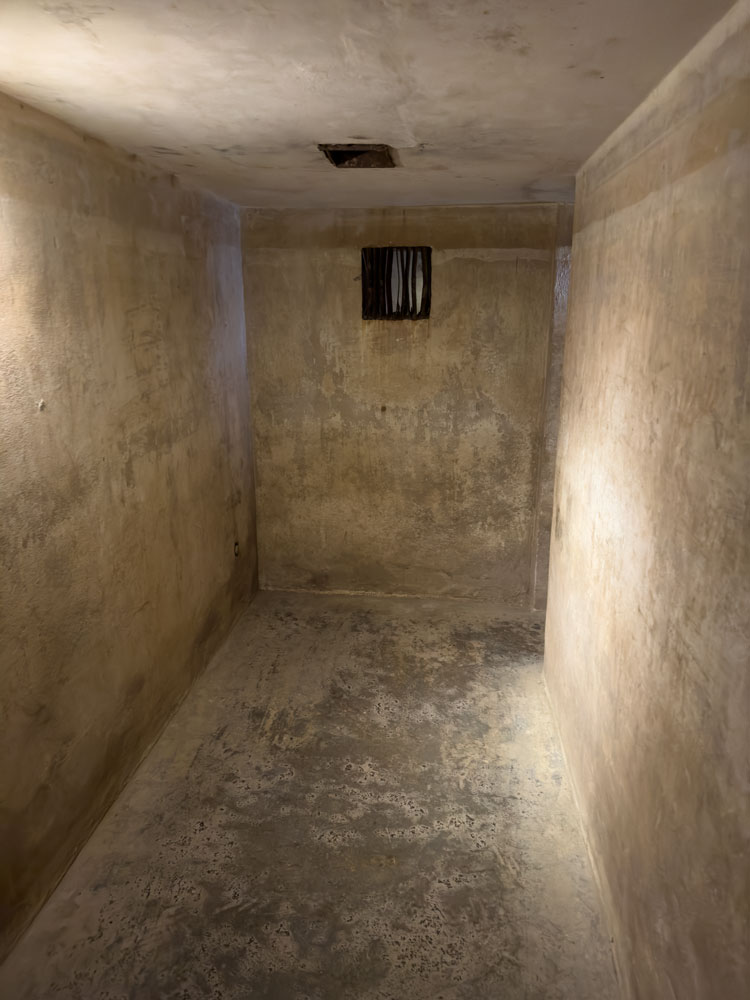
Another room.

After the tour, we had a light snack and then it was to bed. We have an early departure tomorrow and will have to wake up about 4:30 to be ready. Bag pull is 9pm tonight.